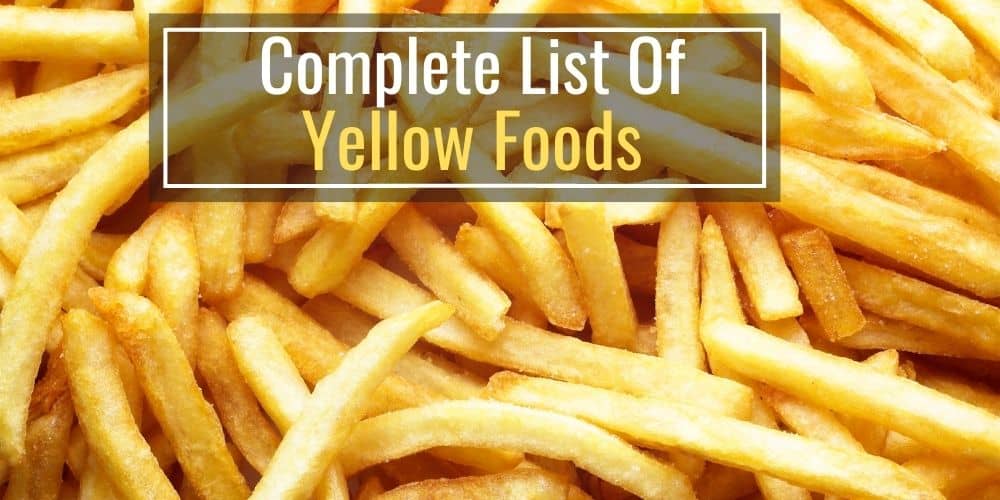While different foods come in different colors, we’re focusing on yellow foods today.
From bananas to zucchini, there are plenty of delicious yellow foods to add to your diet.
Read on to see the entire list of yellow foods and learn more about each one.
Here is a list of all the different food-colored lists with pictures if you’re looking for other colored foods:
1. Acorn Squash
The first yellow food on our list in alphabetical order is acorn squash.
Acorn squash is a type of winter squash that has a teardrop shape. It is yellowish skin with lighter streaks running down its body and has a sweet, nutty flavor.

Acorn squash contains vitamins A, B, and C. It is a vegetable that can be eaten raw, roasted, or baked. It also makes for delicious soup and casserole dishes!
Acorn squash is native to Central America and Mexico. It was first cultivated by Native Americans and later introduced to Europe by the Pilgrims.
2. Asian Pears
Asian pears are a yellow fruit that’s often used in salads, desserts, and as a snack.
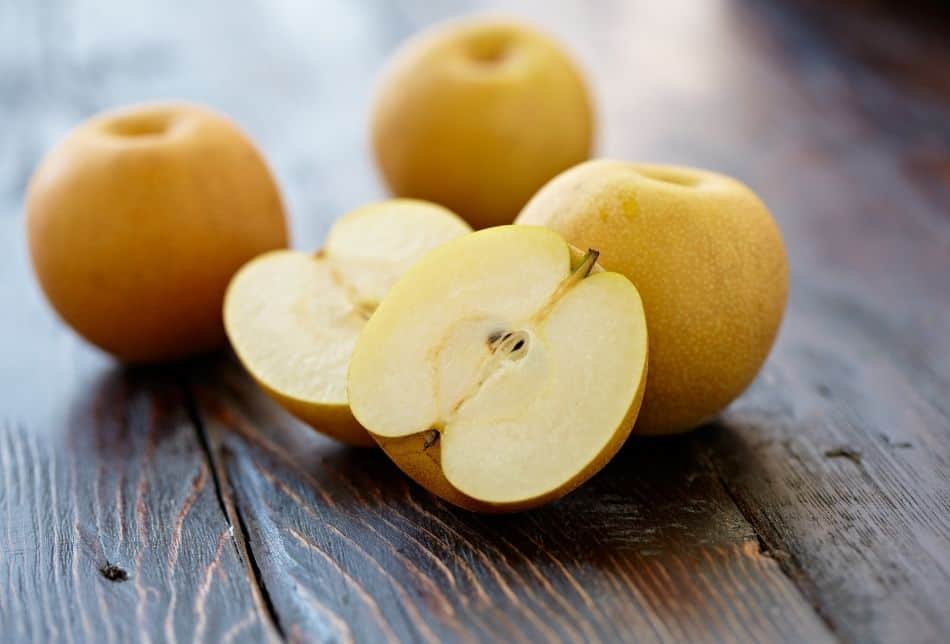
They’re also known as Japanese pears or Nashi pears and are native to China and Japan. Asian pears are crisp and juicy, with a sweetness similar to apples.
Asian pears are a good source of fiber, vitamins C and K, and copper. They also harbor polyphenols, which are antioxidants that can help protect against disease.
The maximum yield from a single tree is three tons.
3. Banana
The next yellow food on our list is bananas.

A banana is a delicious fruit that changes color as it ripens. Bananas start green and turn yellow, then brown before getting black.
Native to the Malay Archipelago in Southeast Asia, a banana is an edible curvy fruit and a great dietary potassium and fiber source. You can gulp it raw or make smoothies, chips, and more with it.
A single banana is called a finger, whereas a bunch of bananas is called a hand.
4. Bartlett Pears
First cultivated in the 1700s in the United States, yellow pears are sweet and juicy with thin and delicate skin.
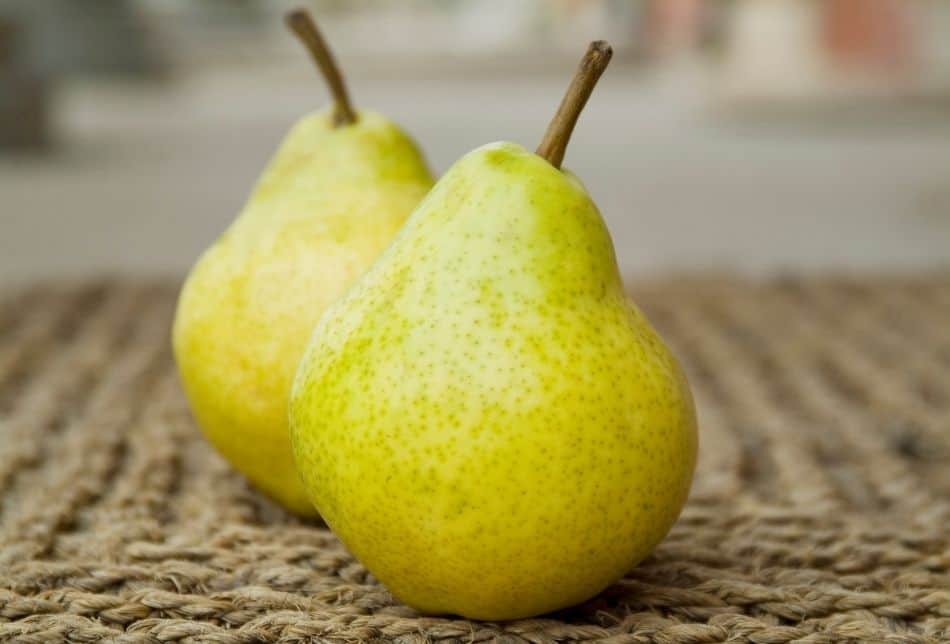
It is a delicious way to get your daily dose of vitamins C and K as well as copper. It can be used in cobblers, pies, or salads for added flavor while also providing healthy nutrients like fiber.
Pears ripen inside out, so the best way to tell if a pear is ripe is to press the flesh near the stem. If you press it easily, it’s ripe and ready to eat.
5. Besan Chilla (Chickpea Pancake)
Besan chilla is a type of pancake made with chickpea flour. It is popular in India and can be eaten for breakfast, lunch, or dinner.
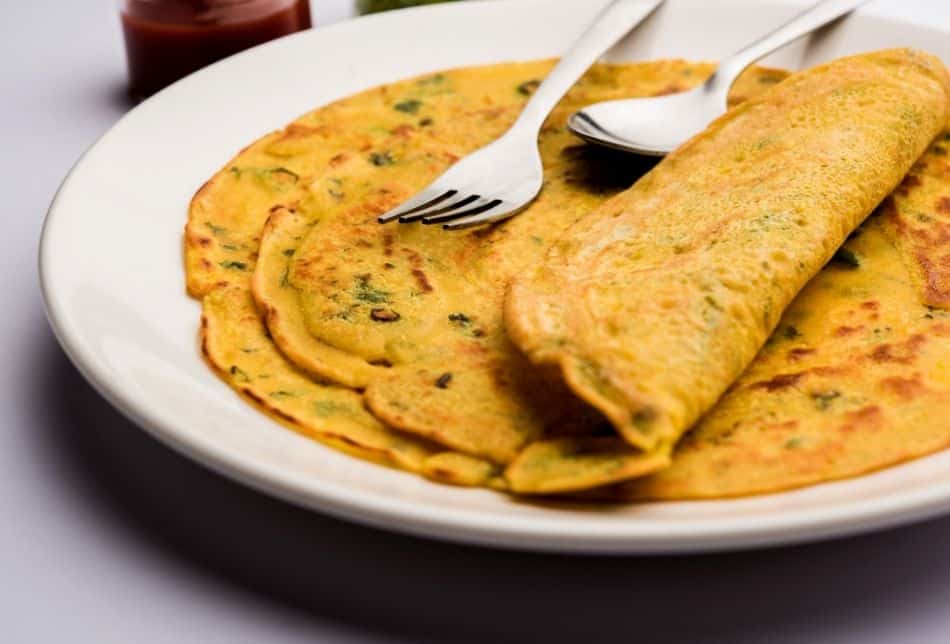
Besan chilla is high in protein and fiber. It is also a good source of iron and manganese.
Besan chilla is usually made with onion, green chili, and ginger. It can be then served with yogurt or chutney.
Besan chilla was first made in India. It is now eaten in several other parts of the world, including the United States.
Make sure to soak your chickpeas before making Besan Chilla. Check out this article to learn how long you can soak chickpeas.
6. Butter
Butter is a yellow substance made by churning milk or cream and has been eaten since ancient times.

It’s used as a spread, an ingredient in cooking and baking, and a topping for some foods. Butter is high in saturated fat, so it’s best to consume it in moderation.
Butter is a good source of vitamins A, D, and E and several other vitamins and minerals.
There are no artificial trans fats found in butter as you get from margarine.
Check out this article if you’re curious if you can refrigerate melted butter.
7. Butternut Squash
Butternut squash is long and has a rounded bottom. The neck is where the squash narrows. Butternut squash comes in many sizes, but on average, they weigh between 1 and 5 lbs.
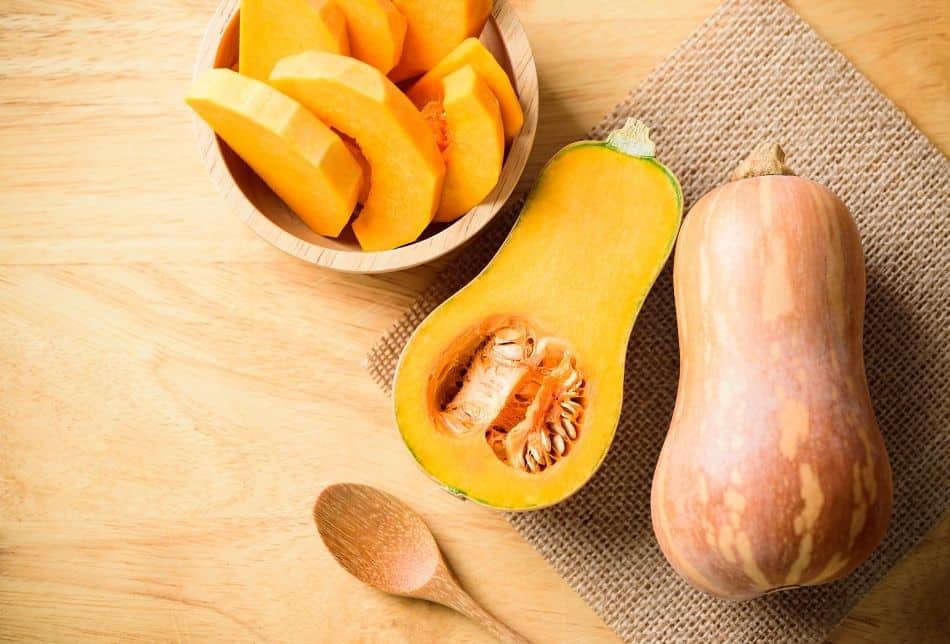
Butternut squash is native to Central and South America. They were first brought to Europe by Christopher Columbus in the 15th century.
Butternut squash is a rich resource of vitamins E and C, potassium, and beta carotene. They can be roasted, mashed, or pureed and used in soups, pies, and other baked goods.
The skin is so thin and moist that you can eat it.
8. Cantaloupe
Cantaloupe is a type of melon that’s native to Southern Africa. It has orange/yellow flesh and a sweet, honey-like flavor.
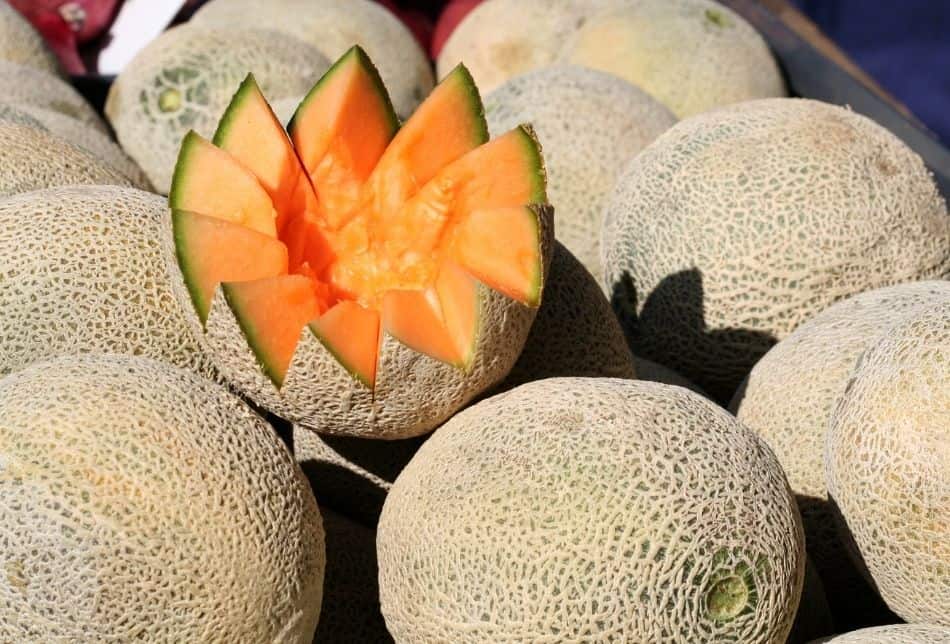
Cantaloupes are a fantastic source of vitamins A and C, as well as potassium. Cantaloupe also offers some potential health benefits, including improving digestion or reducing inflammation in the body.
For something truly unique, try Cantaloupe soup. It’s a refreshing and flavorful way to enjoy this summer fruit. Add it to smoothies and salads.
Americans eat approximately 27 pounds of melons every year.
9. Cheese Puffs
The cheese puffs started in America in the 1930s; two companies independently invented them.
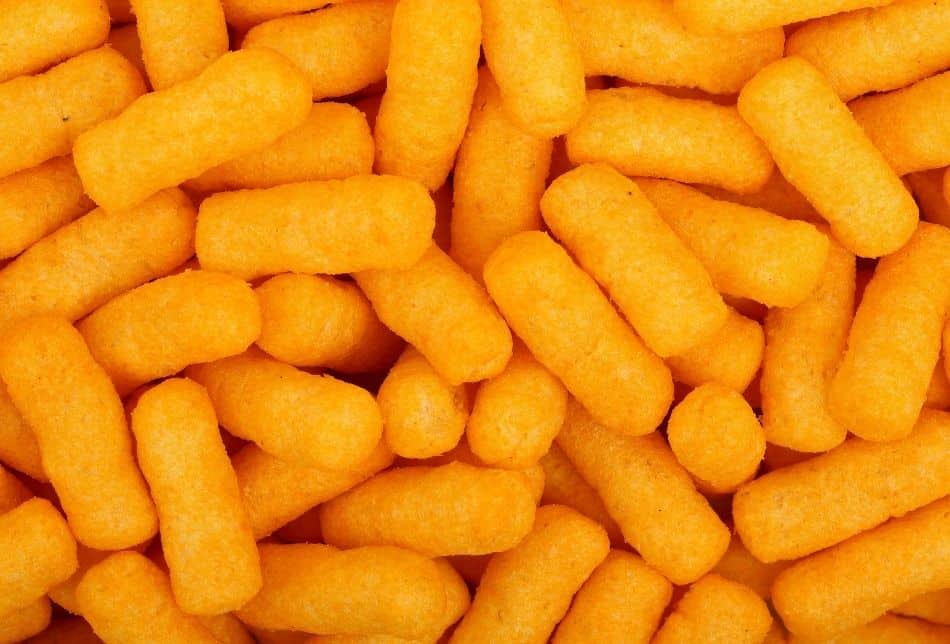
Cheese puffs are a yellow-colored snack food made from cornmeal, flour, and cheese. They are typically fried or baked until they are puffed up and crispy.
Cheese puffs are a good source of protein and are low in carbohydrate content, making them a healthy snack option.
They are high in fat, calories, and sodium.
10. Chrysanthemum Flower Tea
Chrysanthemum tea is a pale yellow beverage that’s made by an infusion of chrysanthemum flowers. The flowers used to make chrysanthemum tea can be dried and used as decoration.
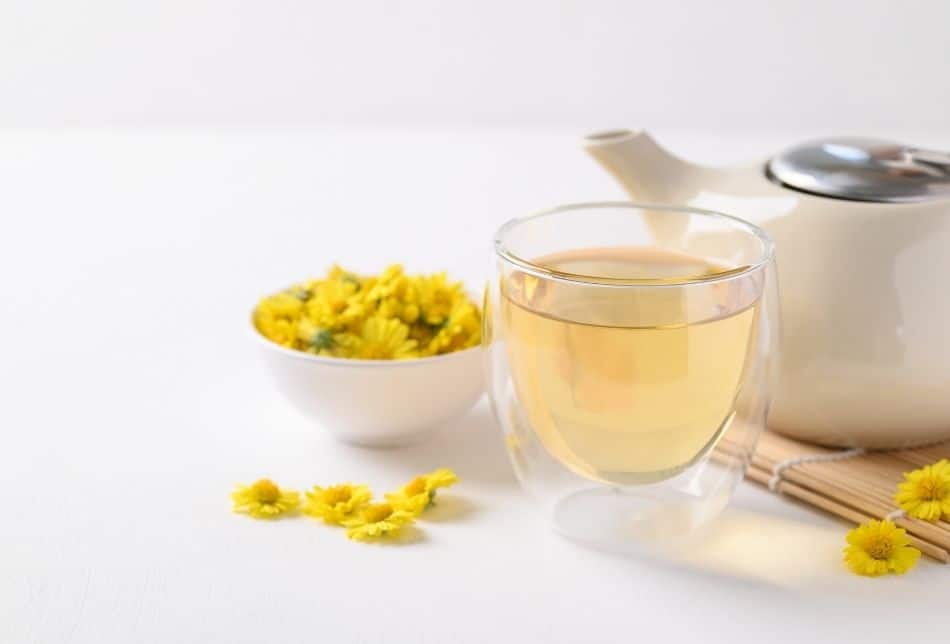
It is a popular health drink in China and other parts of Asia and is thought to have many health benefits. Chrysanthemum tea has a sweet and floral flavor.
Chrysanthemum flower has a chemical called pyrethrum—a natural bug repellent.
11. Corn
Corn is a yellow grain used as a food or feed and was domesticated in Mexico first.
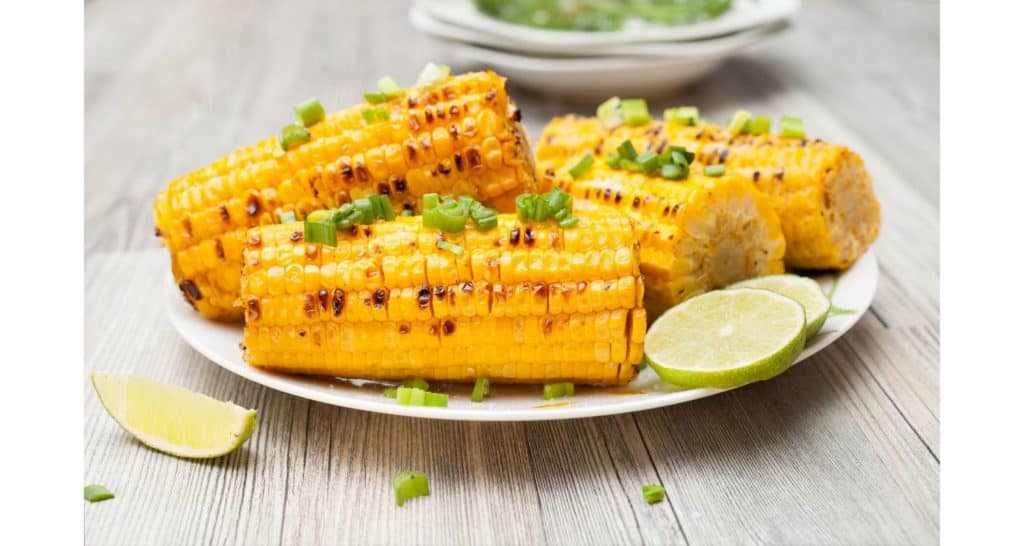
It’s the main ingredient in cornmeal, popcorn, and tortillas. Corn is also used to make ethanol, a type of alcohol that can be used as fuel.
Corn is a good source of fiber, vitamins A, B, C, K, and B6, and minerals such as potassium and magnesium. It’s also a good source of antioxidants.
Most of the corn sown in the United States is genetically modified.
12. Cornbread
Cornbread is a bread made with cornmeal. It is famous in the Southern United States, where it is often served as a side dish to meals.
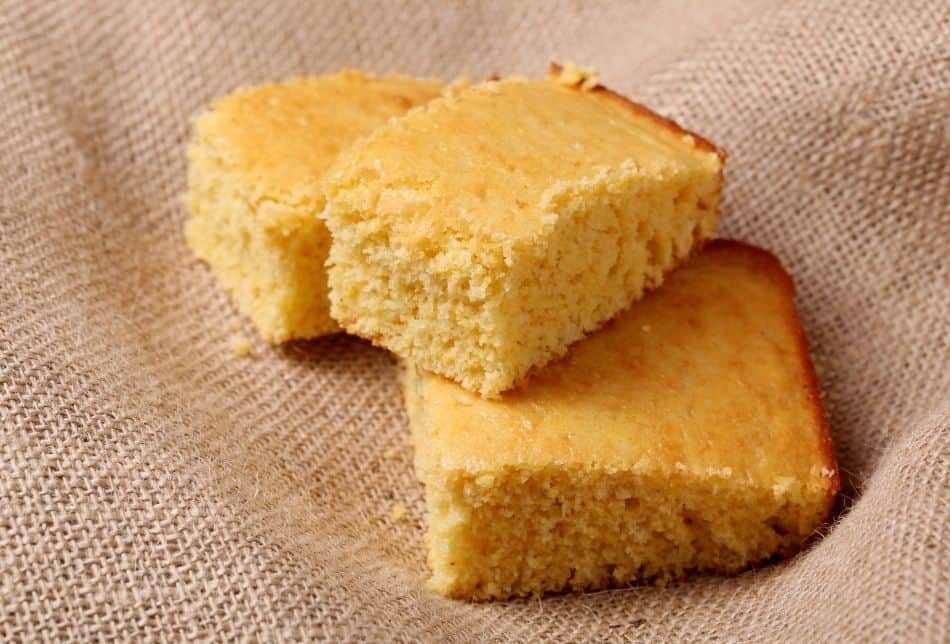
Cornbread is usually denser and sweeter than other types of bread. It can be made into muffins, cakes, or even fried.
Cornbread is a good source of carbohydrates. It has a low content of fat and calories.
Cornbread was first made by Native Americans; British colonists were the first ones to create this batter bread.
13. Cornflakes
Cornflakes are a breakfast food that’s made from milled corn.
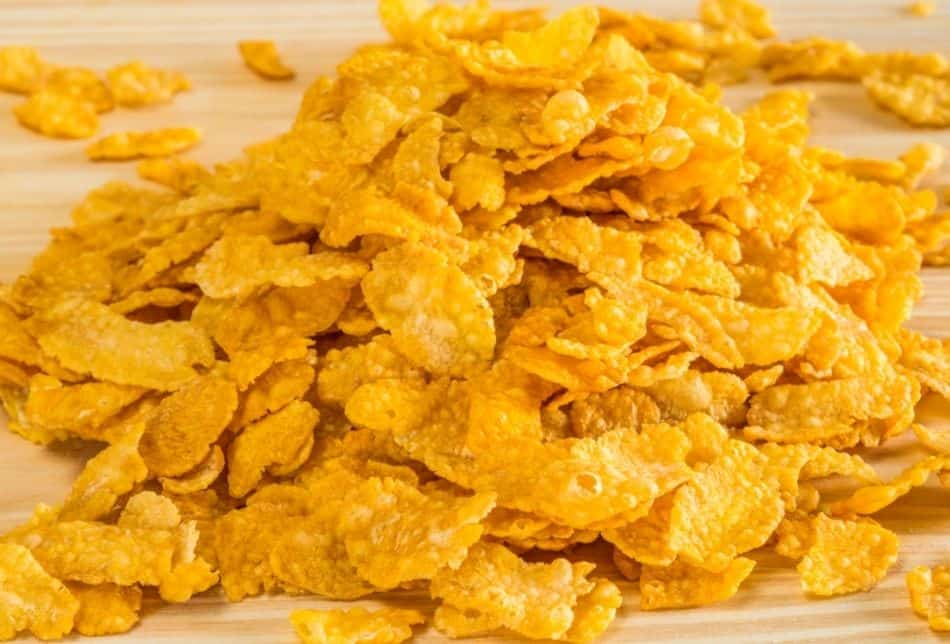
They were first created by Dr. John Harvey Kellogg in 1894 as a healthy alternative. Cornflakes are typically served with milk and sugar.
Cornflakes are a good source of vitamins B and C, as well as iron and folic acid.
Cornflakes have a high glycemic index value, making them unhealthy for diabetic people.
14. Cow’s Milk Cheese
Cow’s milk cheese is a yellow cheese that’s made exclusively from cow’s milk.

Cheese made without annatto is usually pale yellow and deep orange; otherwise, it’s white.
Even before recorded history, people were eating cheese. This yellow food has a creamy texture and a mild, slightly sweet flavor. Milk cheese is a good source of protein, calcium, and fat.
As many as 2000 varieties of cheese are available worldwide.
15. Crookneck Pumpkin
Crookneck pumpkin is a winter squash type with a long, curved neck and rounded bottoms.
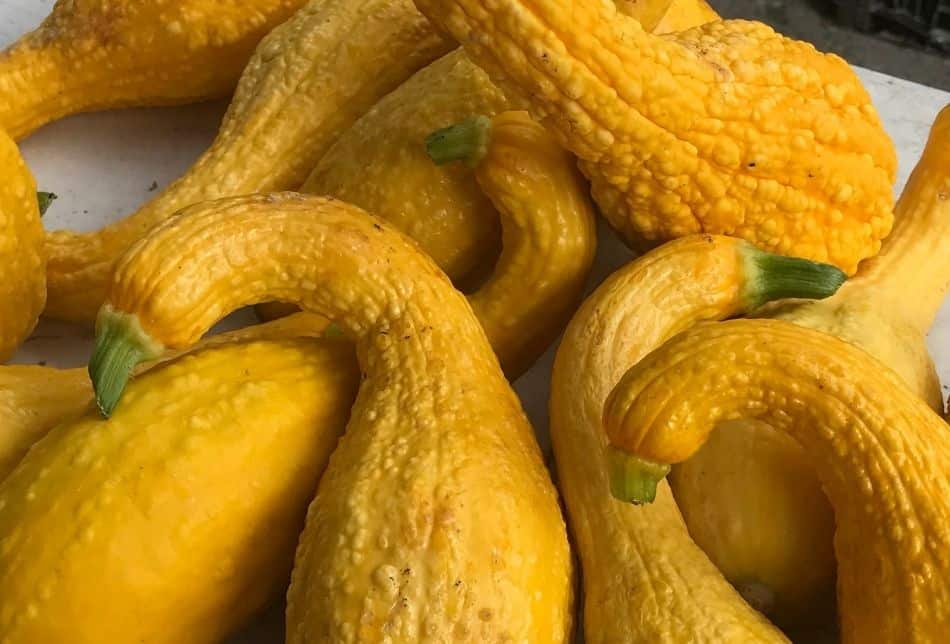
Crookneck pumpkins, also known as yellow squash, have a sweet, nutty flavor and can be eaten cooked or raw. Crookneck pumpkins are full of vitamins A and C.
They also contain fiber, potassium, and magnesium.
Crookneck pumpkins are native to Central America and Mexico and were first introduced to the United States in the early 1700s. Eat them in soups, pies, or stews.
It is low in fat and calories.
16. Durian
The durian is a fruit that’s native to Southeast Asia. It has a spongy, yellow flesh that’s encased in a hard, spiked shell.
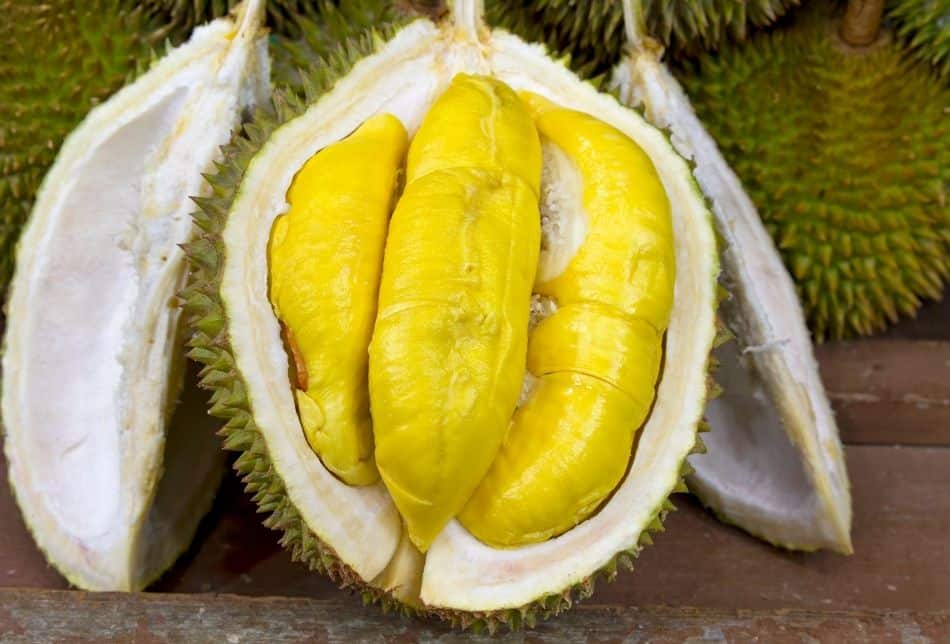
Durian is often hailed as the “king of fruits” due to its large size and unique flavor. The fruit has a sweet, creamy taste that’s often described as being similar to custard.
Durian is a good source of vitamins C and B6, as well as iron and magnesium. It’s also high in fiber and fat.
The durian is sometimes known as a “smelly fruit” because it has a strong, pungent odor.
17. Egg Yolk
Another yellow food is egg yolk. The yolk is the yellowish gooey part of an egg. It’s surrounded by white, which is made up of the egg’s albumen.
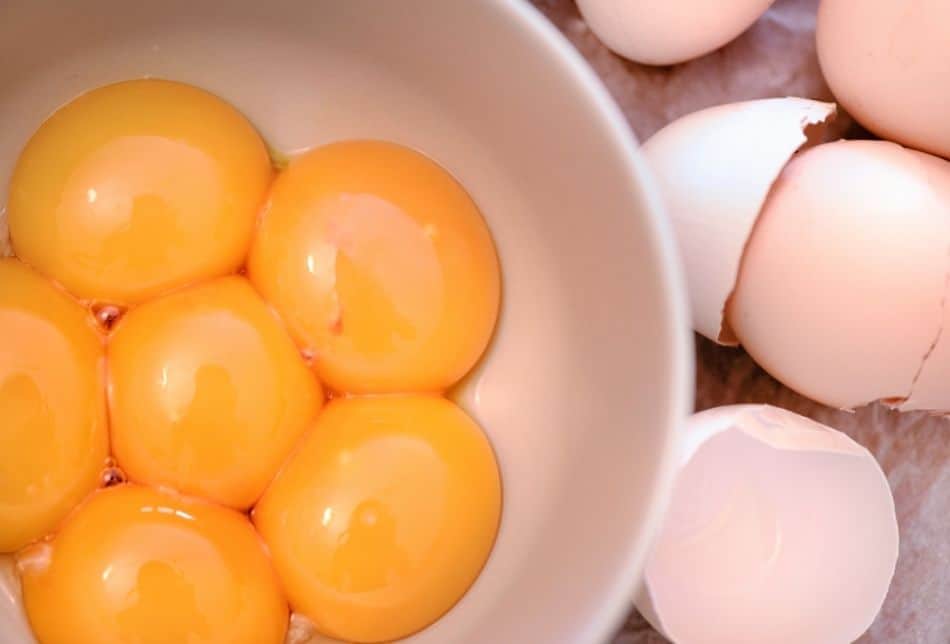
The human race has been consuming eggs for 6 million years now.
Eggs are an amazing warehouse of protein, fat, vitamins A, D, and E, and several other vitamins, selenium, calcium, and zinc.
Egg yolks should be cooked before eating, as they can contain bacteria that can cause food poisoning.
18. Eggfruit
Eggfruit is a yellow-orange fruit that’s native to Mexico.
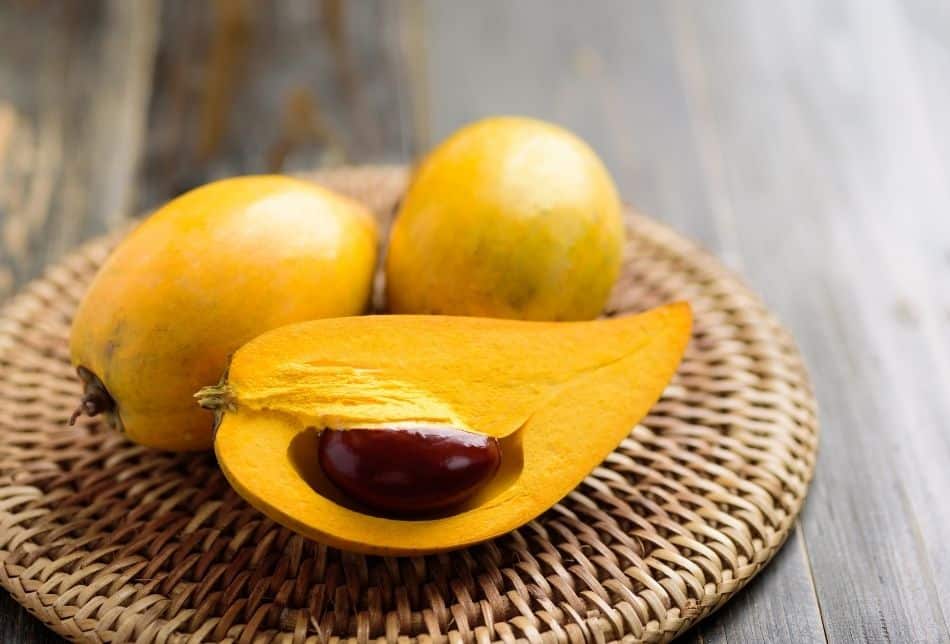
It has a dense, smooth, creamy flesh that’s similar in texture to a hard-boiled egg yolk. The flavor is rich and rejuvenating as sweet potato, but it is much more delicate.
You can use the egg fruit in various recipes, including baking and simmering. Eggfruit is a good source of vitamins A, C and potassium, and fiber.
It’s also low in calories.
19. Field Pumpkin (Winter Squash)
Pumpkins are a variant of winter squash native to many parts of America.
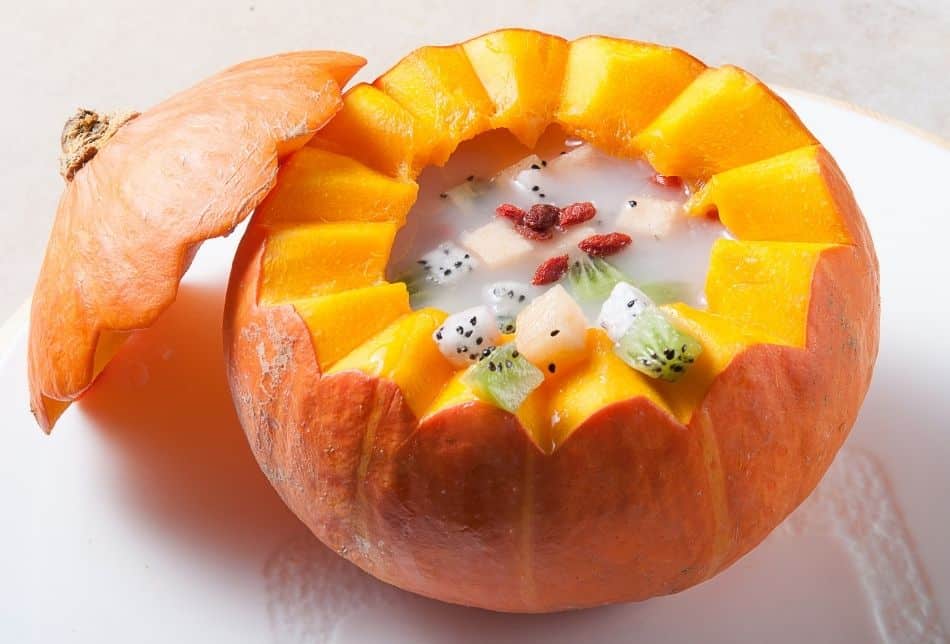
Field pumpkins are the most common type of pumpkin. They are used to making pumpkin pie, jack-o’-lanterns, and other dishes.
Field pumpkins are rich in vitamins A and K as well as fiber with plenty of other minerals like potassium or magnesium. You can enjoy them fried BBQ style or on top salad greens.
Field pumpkins are a good source of fiber and beta-carotene.
20. French Fries
French fries are a yellow food often served as a side dish or snack.
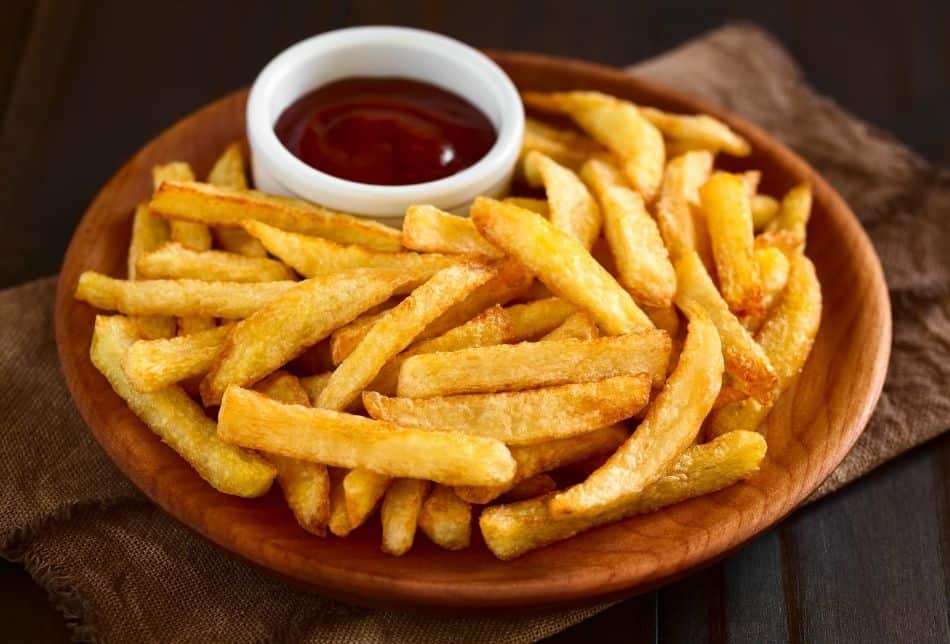
Ironically, they are first made in Belgium and not France. They are usually prepared by frying potatoes in oil and seasoned with salt.
French fries are high in calories and fat, so they should be eaten in moderation.
They are a rich resource in vitamins C and B6, as well as potassium and fiber.
McDonald’s in Japan offered chocolate-drizzled french fries in 2016 and 2017.
21. Gold Kiwi
The gold kiwi is a type of kiwifruit that’s native to China (eastern and central).
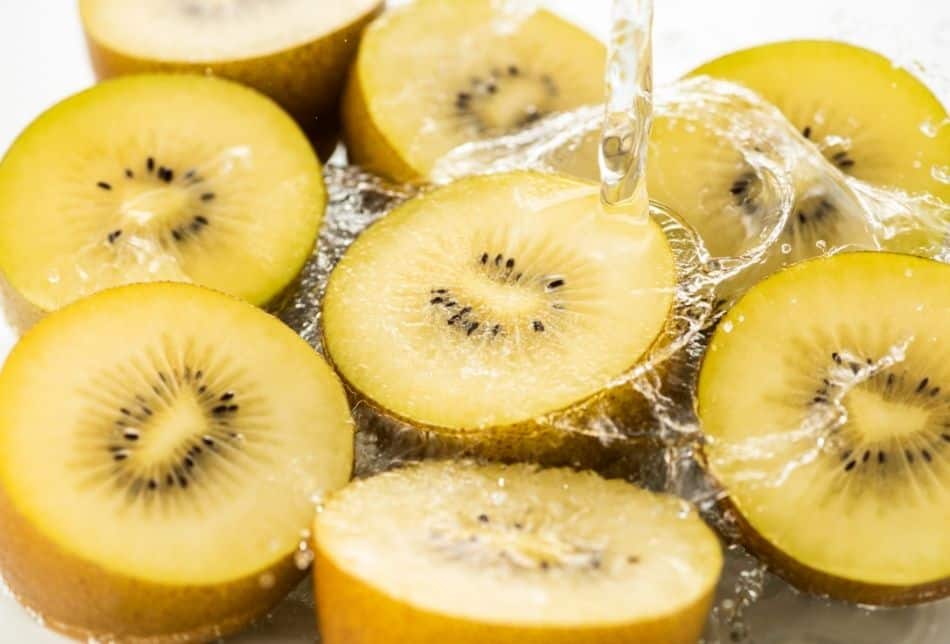
It’s similar in appearance to the green kiwifruit but has a golden-yellow flesh.
Gold kiwis are slightly sweeter and less acidic than green kiwis.
Gold kiwis can be eaten raw or used in recipes.
They’re full of vitamins C and E as well as antioxidants that fight against free radicals inside your body.
You can even eat its skin.
22. Golden Beets
Golden beets are a type of beet with a beautiful yellow color. They have a slightly sweeter flavor than red beets and can be eaten raw, roasted, pickled, or made into juice.
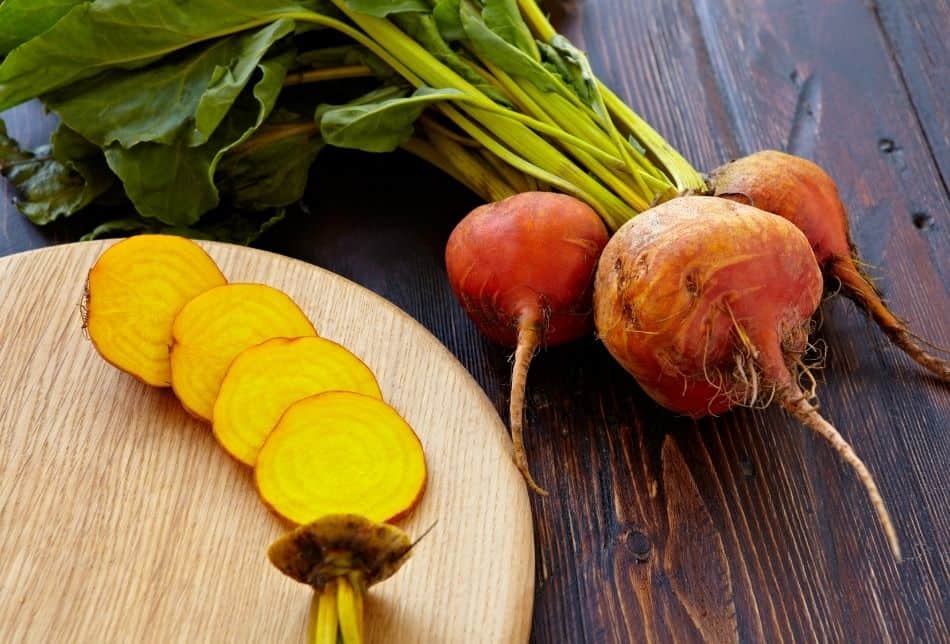
Golden beets harbor vitamins C and B9, as well as potassium and fiber. They can be put into salads, soups, or roasted as a side dish.
Golden beets were first cultivated in Italy or Germany around 1542.
They were introduced to the United States and were well established in the 18th century.
Golden beets do not stain surfaces like their red counterparts.
23. Golden Delicious
The next yellow food on our list is Golden Delicious. It is a historic apple variant that has yellowish-green skin.
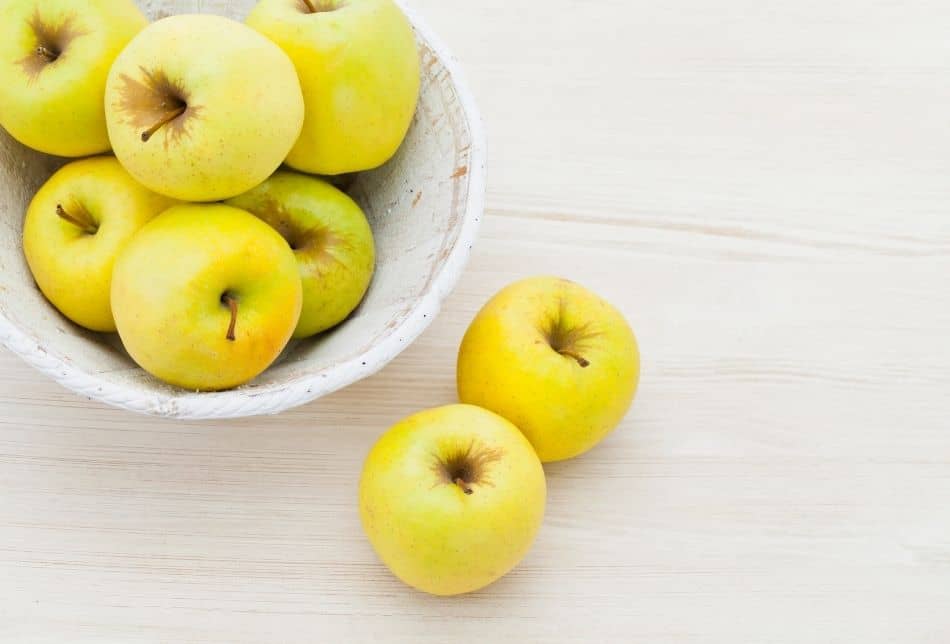
The cultivar is one of the most popular yellow apples. Golden Delicious is crisp and sweet with a slightly tart flavor.
This fruit is originally from Clay County, West Virginia, first introduced in 1905.
Golden Delicious apples are rich in dietary fiber and vitamin C.
They can be consumed fresh or used in salads, apple butter, and apple sauce.
Golden Delicious that grows in colder regions tastes sweeter than those in the hotter regions.
24. Honey
Honey is a sweet food that’s made by bees and is as old as the written history. It’s often used as a sweetener in food and drinks or as an ingredient in baking.

Honey has many known and unknown health benefits, including reducing inflammation and boosting immunity. It’s also a good resource of antioxidants and has anti-bacterial properties.
The average bee worker produces about 1/12 teaspoon of honey in its lifetime.
Honey does not spoil. Whether you decide to keep honey on the shelf or in the freezer, honey will not spoil.
25. Jackfruit
It is a tropical fruit with a sweet, yellow flesh similar in texture to meat. The original birthplace of jackfruit is India.
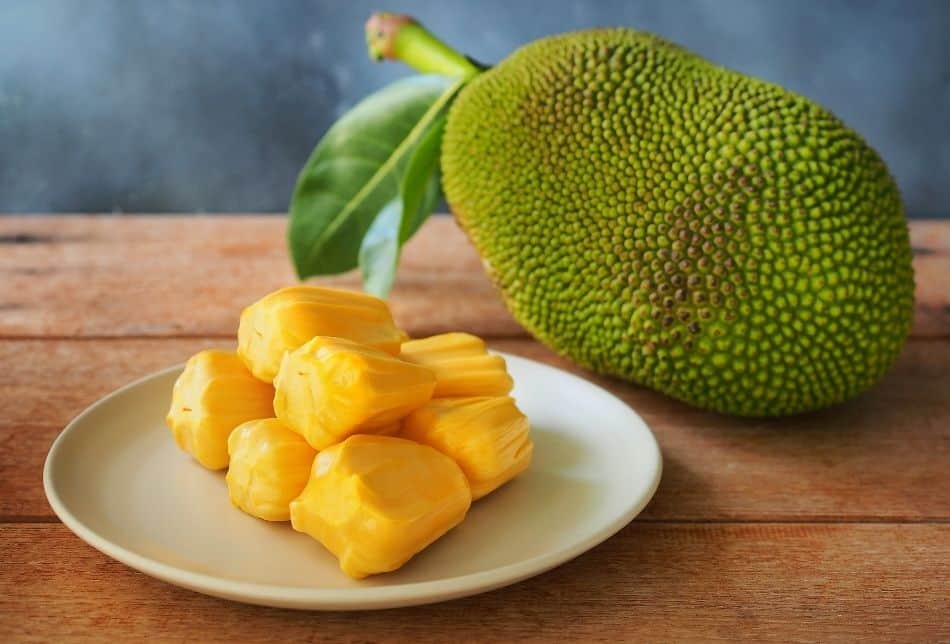
The jackfruit tree can grow up to 30-40 feet tall, and a mature tree can produce up to 500 fruits per year.
Jackfruit is a good source of vitamins C, while seeds are an ideal source of protein. It’s also low in fat.
The largest recorded jackfruit was 42.72 kg (discovered in India). The tree can live up to 60 to 70 years.
26. Lemon
The second yellow food on our list is the tangy lemons.

Lemons are bright yellow and can be distinguished from their green counterparts-limes easily.
To enjoy it, you can add juice to water, smoothies, salad dressings, sauces, or baked goods.
These small fruits are thought to be natives of north-western India and are a great source of vitamin C. Lemons are also a good source of dietary fiber, which can help in digestion.
Biologically, lemons are berries.
27. Lemon Boy
The next yellow food is Lemon Boy. It is a yellow-colored tomato.
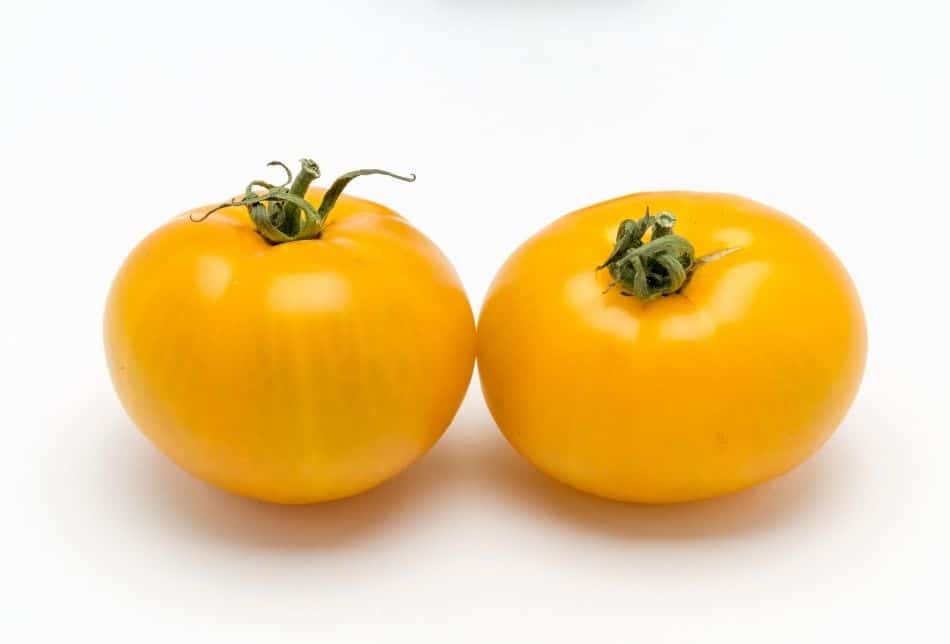
Lemon Boy tomatoes are known for their tangy and are therefore added to salads, salsas, or sandwiches for their flavor.
They have antioxidants such as vitamins A and C, besides potassium and dietary fiber.
Lemon Boy tomatoes were developed by the Petoseed company and were introduced in 1984. They are a determinate variety, meaning they will produce fruit all at once and then stop growing.
The lemon boy is resistant to almost all the major pests and diseases that other tomato varieties are prone to.
28. Longan
A native of China and Southeast Asia, longan has a long history of cultivation.
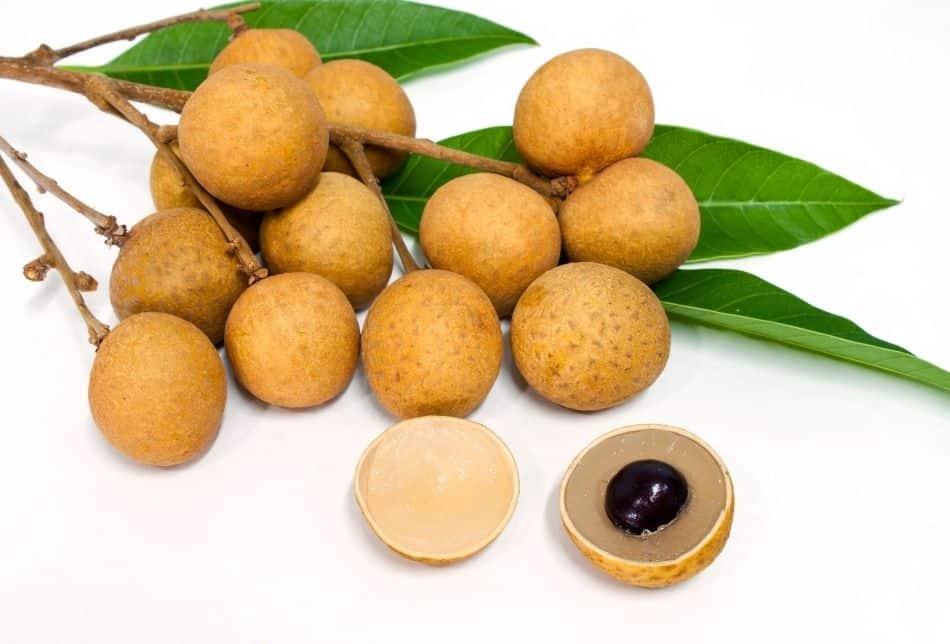
It has a thin, yellowish-brown shell with a white flesh that’s similar in appearance to lychees.
The taste of longan is sweet and succulent with a hint of floral flavor. It’s often added to desserts or eaten as a snack. It is also used in soups in fresh or dried food.
Longan is a good source of vitamins B and C, as well as potassium and copper.
The name longan means “dragon’s eye” in Chinese because the fruit resembles an eyeball when it’s peeled.
29. Loquats
Loquats are a type of fruit that’s native to the hills of southeastern China. They have yellow or orange flesh with seeds in the center.
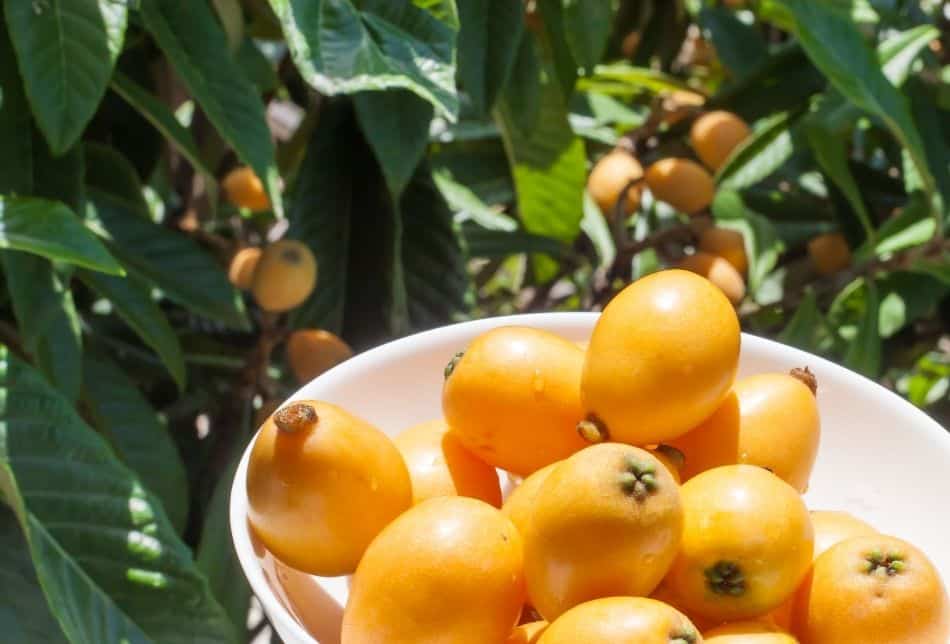
Loquats are typically eaten fresh but can also be cooked and used in pies or jams, like peaches and apples.
These fruits are rich in vitamins A, B, and potassium. They also provide you with important minerals such as magnesium.
Seeds of loquat can be used to prepare liquor.
30. Mac and Cheese
The last yellow food on our list is Mac and cheese.
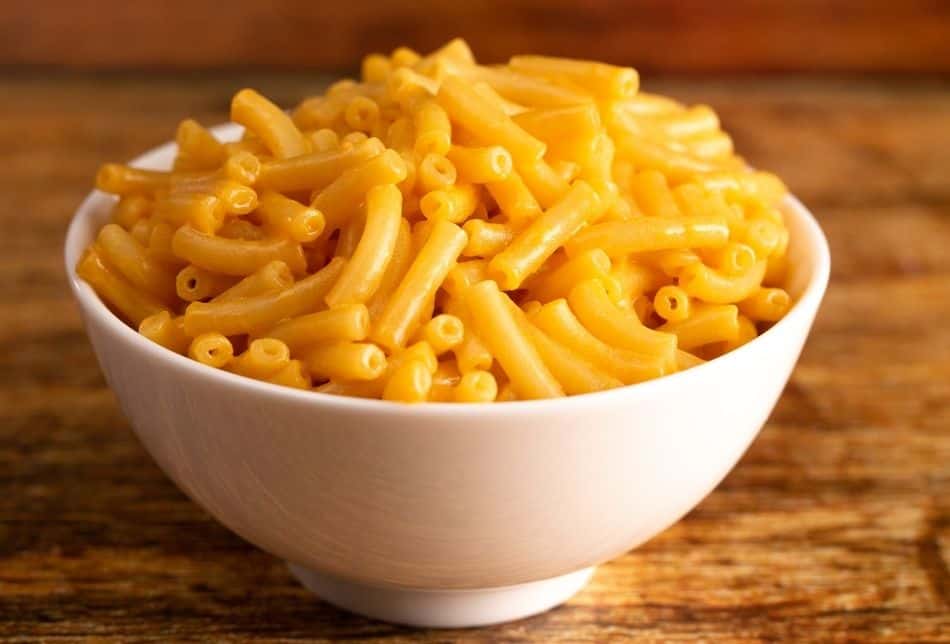
Macaroni and cheese is a classic dish that people of all ages love. It consists of elbow-shaped pasta in a creamy cheese sauce.
Mac and cheese is believed to have originated in Italy, but it wasn’t popular until it was brought to America by Italian immigrants in the 18th century.
While there are many types of mac and cheese, the most popular type is made with cheddar cheese.
31. Mango
An edible mango is yellow and turns orange as it ripens more.

The birthplace of mangoes is India; from here, they are believed to have spread to other parts of Asia and then to the rest of the world.
Mangoes are not only delicious but they’re also packed with nutrients. The stone fruit contains vitamins A, C, and E and potassium and fiber.
There are approximately 1,000 varieties of mangoes in the world, so there’s sure to be one that you’ll love.
32. Mirabelle Plum
The Mirabelle plum is a small, tart-flavored fruit that’s yellow or amber.
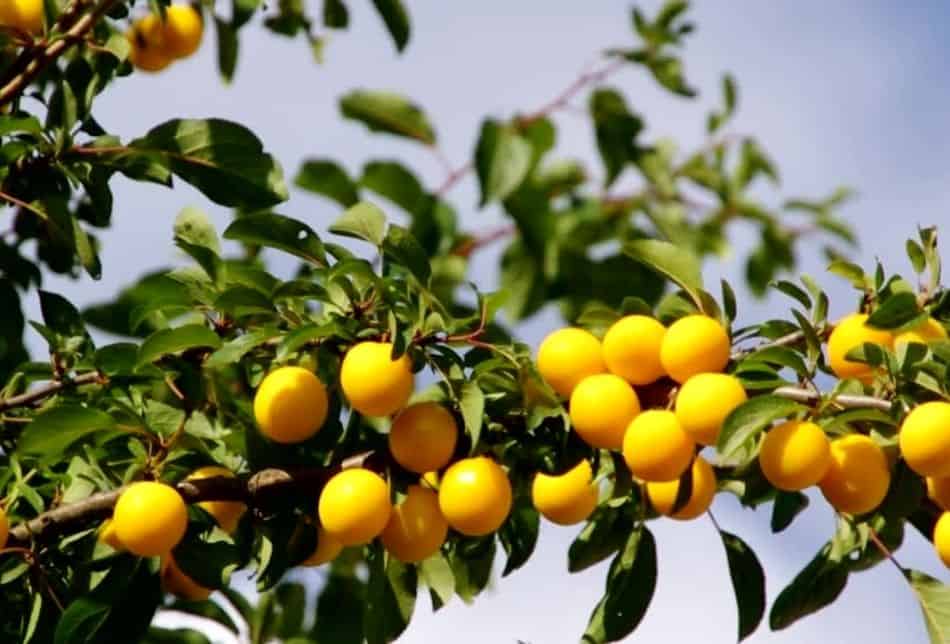
Mirabelle plums come from the Loraine region of France, and it’s often used in jams, jellies, and desserts.
Mirabelle plums offer a good source of vitamins A and C and dietary fiber.
When buying Mirabelle plums, look for ones that are firm and free of blemishes. Avoid fruits that are soft or bruised.
Need a quick shot of energy? Eat Mirabelle plums!
33. Mustard
Mustard is a yellow condiment made from the seeds of the mustard plant.
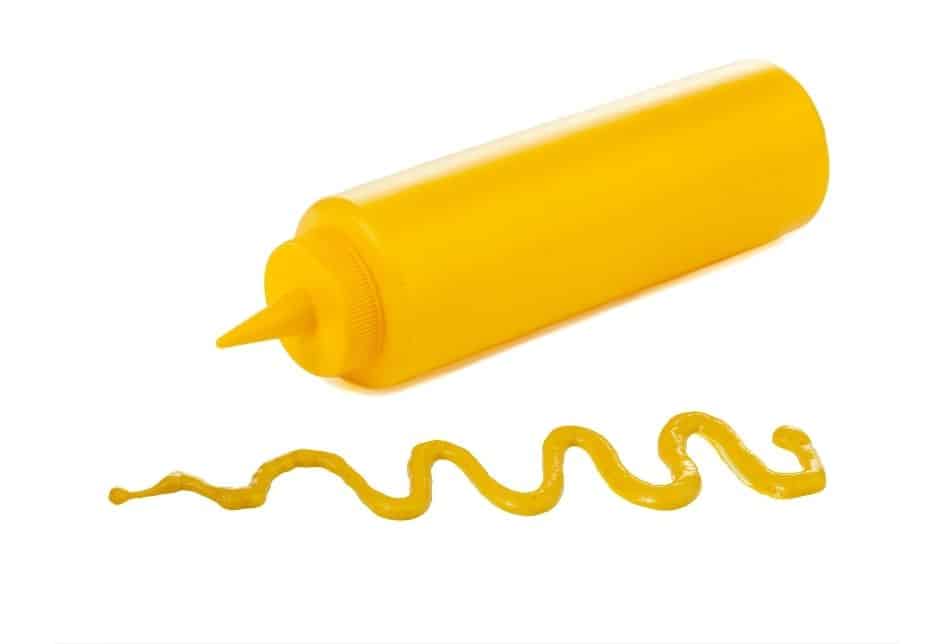
It’s used as a sandwich spread and in various other recipes.
Mustard is also a good source of selenium, a mineral that has been shown to have anti-inflammatory effects on conditions such as rheumatoid arthritis and cancer.
When buying mustard, look for a brand that doesn’t contain any added sugar or artificial ingredients.
The Romans are known for their famous mustard, and they likely were the first to use this condiment.
34. Olive Oil
Olive oil is a type of vegetable oil that’s made from olives. It’s been used for centuries in cooking and as a salad dressing.

It has a greenish-yellow color and a slightly bitter taste.
Olive oil has monounsaturated fat, which has been shown to have various health benefits.
When buying olive oil, look for a brand labeled “extra virgin.” This means that the olives were cold-pressed, and the oil wasn’t exposed to any chemicals or heat.
Olive oil can go rancid if it’s stored in a warm place or exposed to light, so it’s best to stash it away in a cool, dark place.
35. Papaya
The papaya is a tropical fruit with yellow or orange flesh and black seeds.

Papayas are native to Southern Mexico and Central America, but they’re now grown in many tropical countries worldwide. Just cut it open, remove the seeds and relish the taste.
Papayas are a wonderful source of vitamins A, E, and C and fiber and antioxidants.
They have a digestive enzyme called papain, which can help with digestion.
Pregnant women should not eat ripe papaya.
36. Passion Fruit
Passion fruit is a small, round fruit that’s native to South America. It has a tough, leathery skin and a sweet-tart flavor.
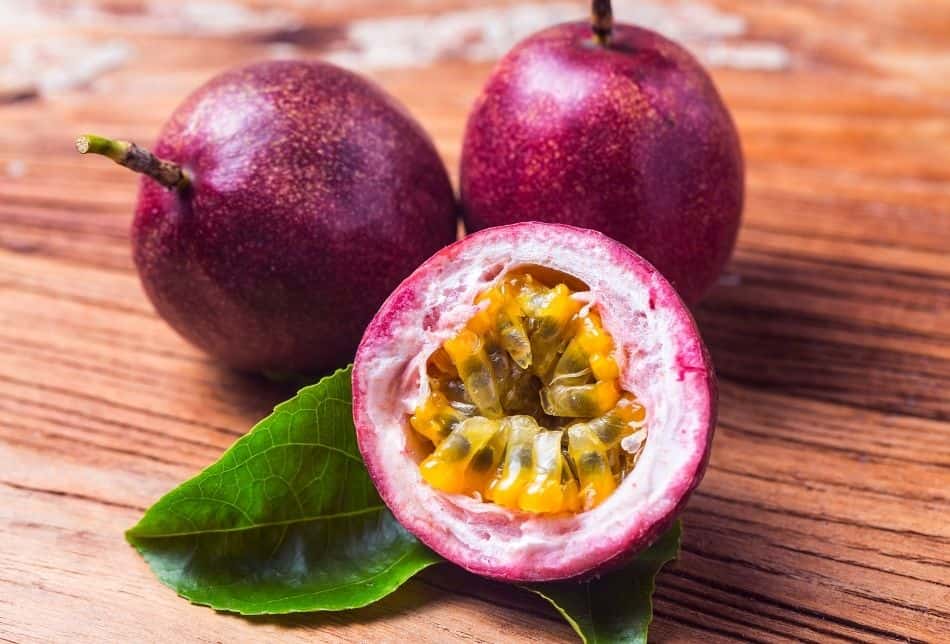
The pulp and seeds of aromatic passion fruit are used in various desserts and drinks.
Passion fruit is also loaded with vitamins A and C and potassium and fiber.
Passionfruit is often a part of tropical cocktails. It has calming properties and can help you sleep well.
37. Peach
It is a type of stone fruit that belongs to the rose family. The flesh of a ripe peach is sweet and juicy, with a velvety smooth texture.

Peaches are from China and have been cultivated there for over 4,000 years.
Spanish explorers brought the peach to Mexico and then America in the 16th century.
Peaches have in them vitamins A and C, as well as potassium and fiber.
There are more than 700 peach varieties in the world. The most common type of peach found in supermarkets is the freestone peach.
In Asia, peaches were once considered a symbol of good luck.
38. Persimmons
The persimmon is a type of fruit native to China, Indochina, and Northeast India. It’s often used in Asian cuisine and has a sweet honey-like taste and apricot-like texture.
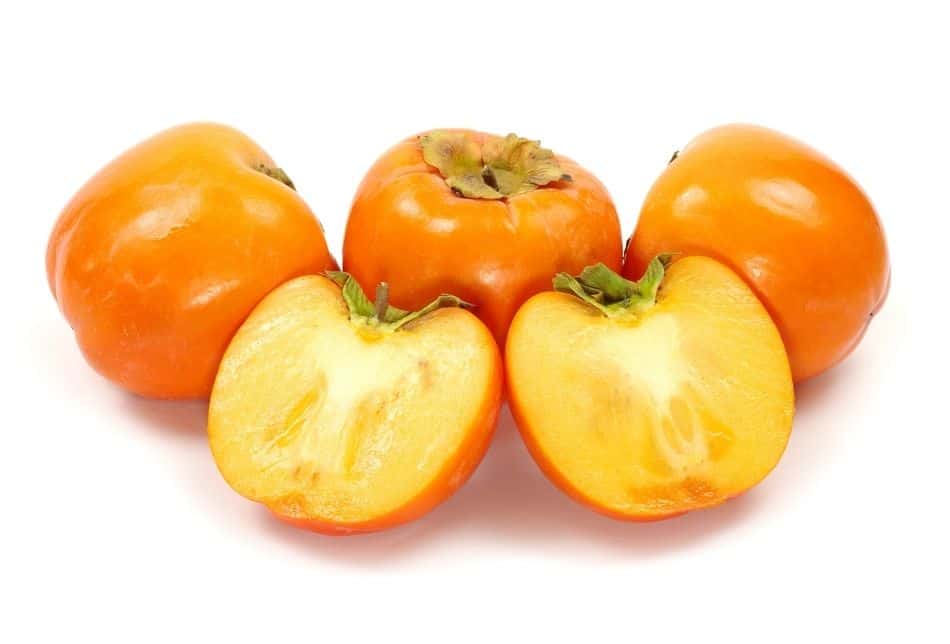
Persimmon is available in two types: the fuyu and the hachiya.
The fuyu is rounder and can be eaten when it’s firm, like an apple.
The hachiya is more heart-shaped and must be eaten when it’s soft, like a ripe tomato.
Persimmons are one of the best sources of fiber, vitamins A and C. They also contain antioxidants which may protect against some chronic diseases like heart disease or cancer.
39. Peter’s Honey Fig
Another yellow-colored food on our list is Peter’s Honey Fig.
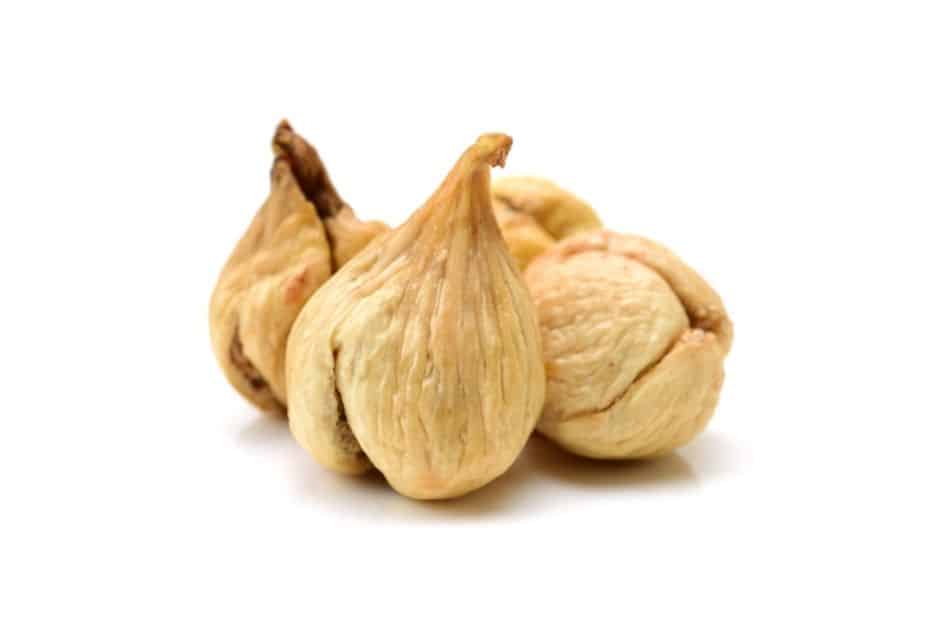
Honey figs are small, yellow-skinned fruits with a sweet, honey-like flavor and chewy texture.
They can be ingested fresh or added to jams, jellies, and pies.
Native to the Mediterranean region, honey figs have been grown since ancient times. They are especially good in dietary fiber, vitamins A and C.
In some cultures, honey figs are considered an aphrodisiac.
40. Pineapple
Pineapple is native to Bolivia, Brazil, and Paraguay. The edible part is yellow, and the exterior too turns yellow (from green-gray) upon ripening.

It’s a popular fruit that is used in many different dishes, including desserts, salads, and main courses.
Pineapple is also used to make juice, jam, and other forms of preserves.
Pineapple is a good source of vitamins C and B1, as well as copper and manganese. It also contains bromelain, an enzyme that can help with digestion.
A pineapple is not an apple or a pine. It is a berry.
41. Rainier Cherries
Yellow cherries are less common than other types of cherries, but they’re just as delicious.
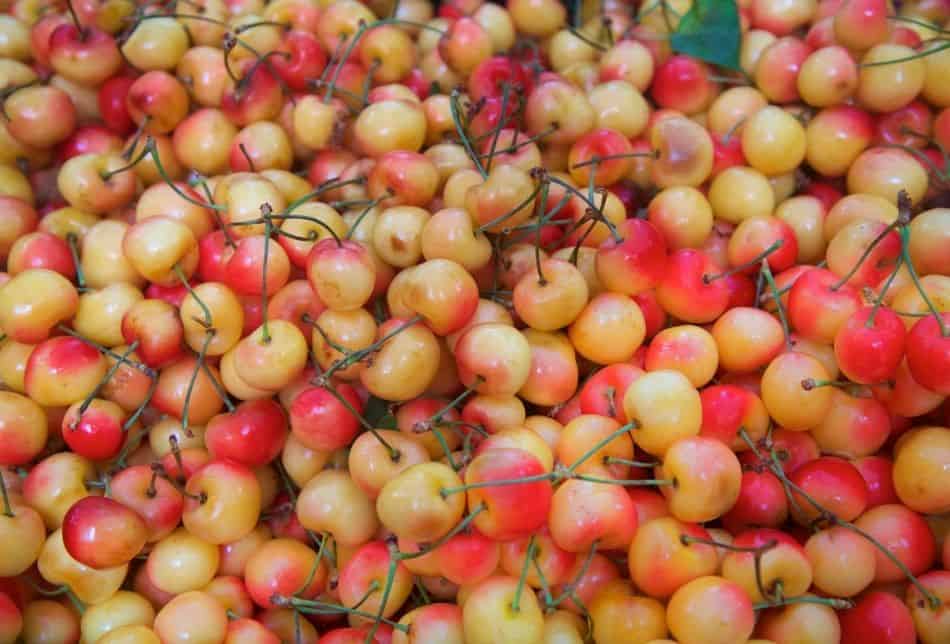
Yellow cherries are originally from Washington, DC.
It has been reported to contain vitamins C and A, as well as fiber with an interesting flavor profile, unlike other fruits you may have tried before.
Eat them fresh or enjoy them in jams/sauces.
National Rainer Cherry Day is celebrated on November 11.
42. Rutabaga
Rutabaga is a type of root vegetable that’s similar to a turnip. It has purple-tinged yellow skin with a swollen, bulbous shape.
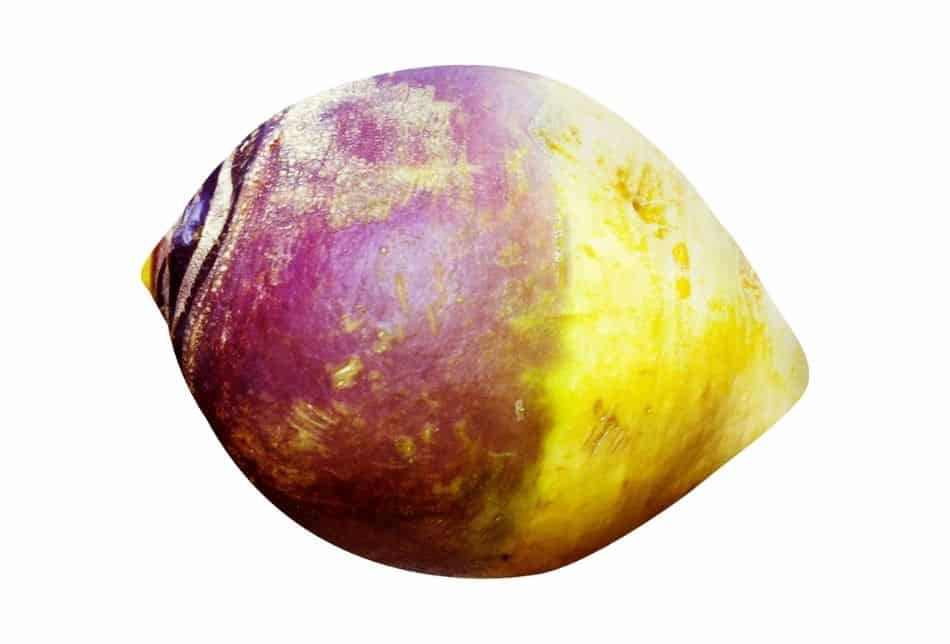
Rutabaga is usually cooked and used in soups or stews. It can also be roasted or mashed.
It contains dietary fiber, vitamins C and E, and potassium and magnesium.
Rutabaga was first cultivated in Europe in the 16th century.
43. Saffron
Saffron is a yellow spice that’s made from the stigmas of the saffron crocus. It has a pungent, slightly bitter flavor and is used as a seasoning in various dishes.

Saffron is also a good source of antioxidants and has been used for centuries in traditional medicine.
Saffron, the world’s most expensive spice, is believed to have originated in Central Asia and was first cultivated in Iran.
The shelf life of saffron is small; six months at the maximum if stored properly.
44. Semolina
The next yellow food on our list is Semolina. It is a type of flour made from durum wheat.
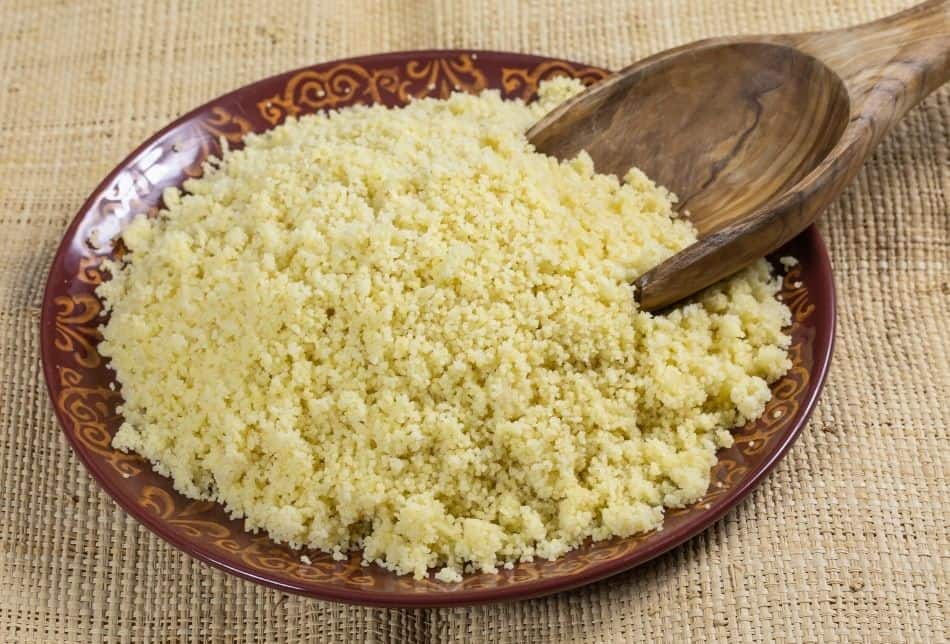
Semolina is a great thickener for stews, soups, and gravies. It’s high in carbs but also full of protein and fiber.
Semolina was first in Central Europe. It is still popular in Italy and other parts of Southern Europe.
Semolina is also used in many African, Middle Eastern, and Asian dishes.
It is low in saturated fat, while Vitamin D is absent.
45. Starfruit
Also known as carambola, starfruit originated in Southeast Asia.
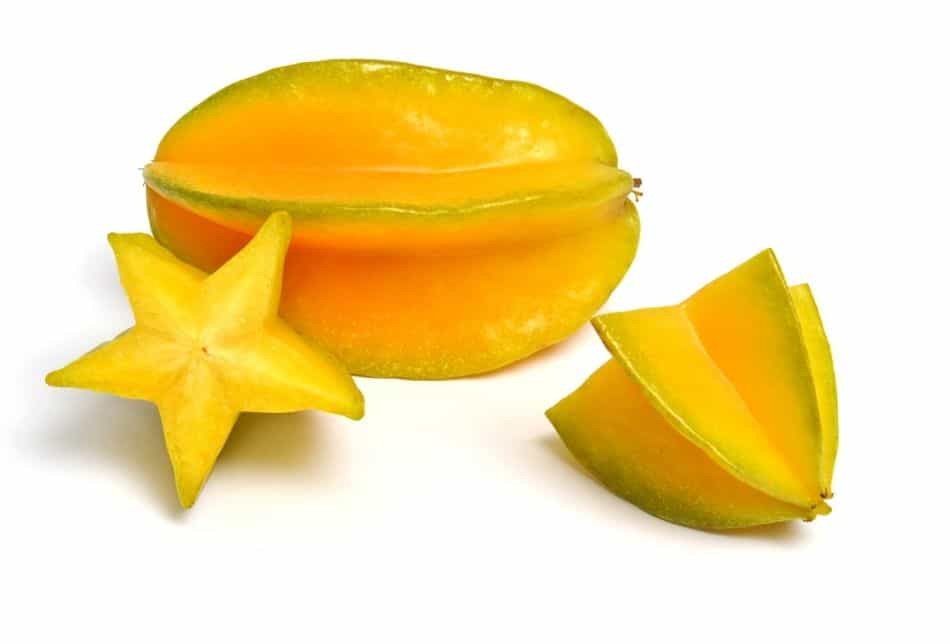
It is shaped like a five-pointed star and has yellow, green, or red skin with five to six ridges running down longitudinally.
The taste of starfruit is sweet and tart with a hint of sourness. It’s eaten in salads, desserts, or as a snack.
Starfruit is a good source of vitamins C and B, as well as magnesium, potassium, and fiber.
Starfruit is perfect for those looking for a low-calorie snack option that’s also packed with nutrients.
46. Sweet Potatoes
Sweet potatoes are a type of starchy root vegetable native to Central and South America. They come in many colors, including yellow.

Yellow sweet potatoes are a great way to get your daily dose of fiber, vitamins A and C, with the added bonus that they offer health benefits such as being good for your heart.
The hue of a sweet potato is directly linked to its beta-carotene content. A more vibrant color indicates a higher amount of vitamins inside!
47. Turmeric
Turmeric is a yellow spice that’s often used in Indian cuisine.

It’s made from the dried and ground roots of the Curcuma longa plant, and it has a strong, earthy flavor.
Turmeric is used in curries, soups, and various Indian dishes.
Turmeric is a good source of copper, iron, potassium, zinc, and magnesium.
It also contains curcumin, a substance that has been shown to have anti-inflammatory and antioxidant effects.
Turmeric can stain clothes, so be careful when handling it.
48. Wax Beans
Yellow beans are a type of legume closely related to green beans.
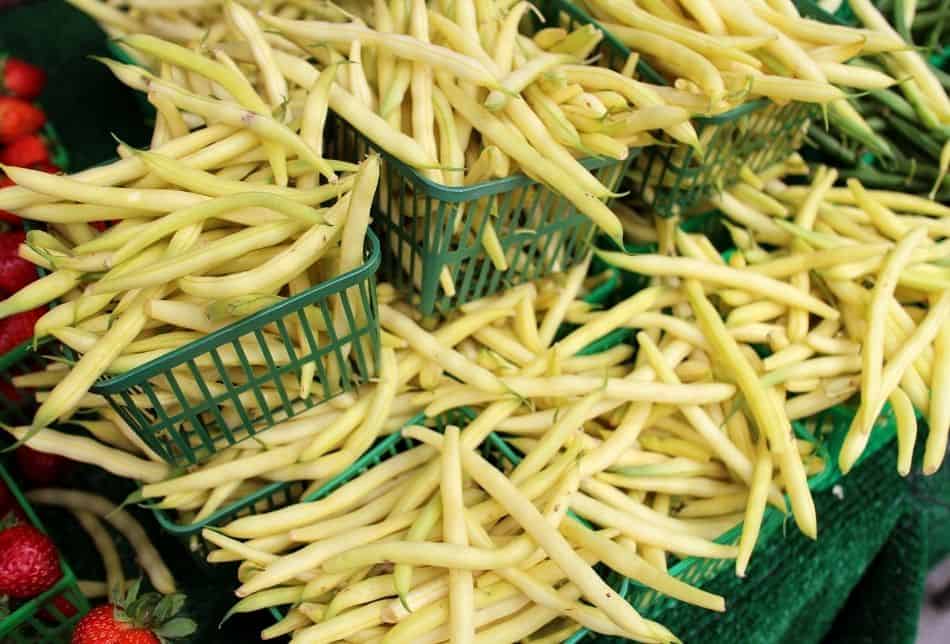
They’re typically longer and thinner than green beans, with a smooth, wax-like texture. Their ancestors belonged to Central and South America.
Yellow Beans are a healthy source of fiber, vitamins, and minerals.
They can be eaten raw or cooked to make any diet better.
The bean cultivar is a rich source of immunity booster folate.
49. Yellow Cauliflower
Cauliflower comes from the Mediterranean region and is available in many colors, including blue, red, purple, and yellow.
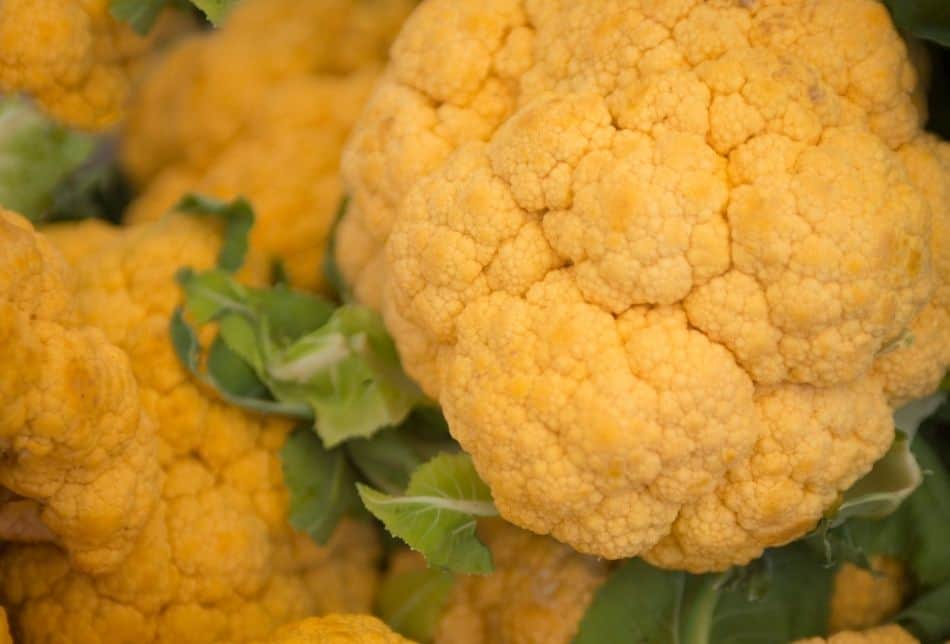
The cauliflower’s natural color changes as it matures. If the head is exposed to direct sunlight for too long, curds will turn dull yellow.
Yellow cauliflower is a versatile vegetable that can be eaten raw or cooked. It contains many healthy nutrients like vitamins C, E, and K as well as fiber with potassium & calcium too.
The orange color is due to the presence of beta-carotene. This substance is also found in carrots and other orange vegetables.
50. Yellow Chili
Yellow chili grows in northern India (Kashmir and Punjab).
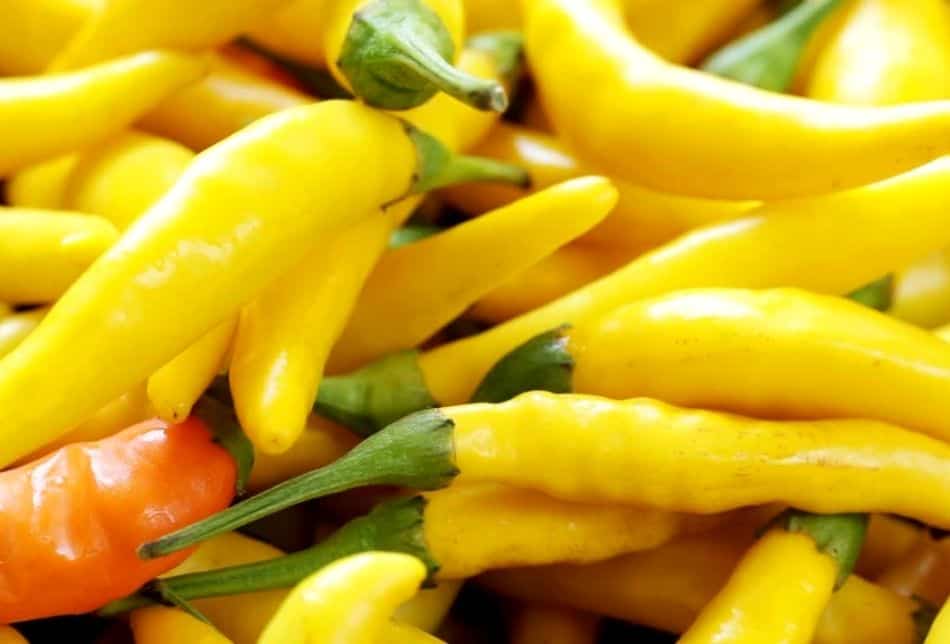
They’re typically used in Indian cuisine. Yellow chili peppers have a milder taste than other types of chili and can range in heat from sweet to hot.
Yellow chili is an excellent source of vitamins A and B6, potassium, and copper.
They also contain capsaicin, a compound that has been shown to have anti-inflammatory and pain-relieving effects.
If you’re hunting for a delicious way to add more yellow chili to your diet, try using them in stir-fries, soups, stews, or curries.
51. Yellow Dragon Fruit
A native of northern South America, the yellow dragon fruit is also known as the pitahaya. It is from the cactus family and grows on vines.
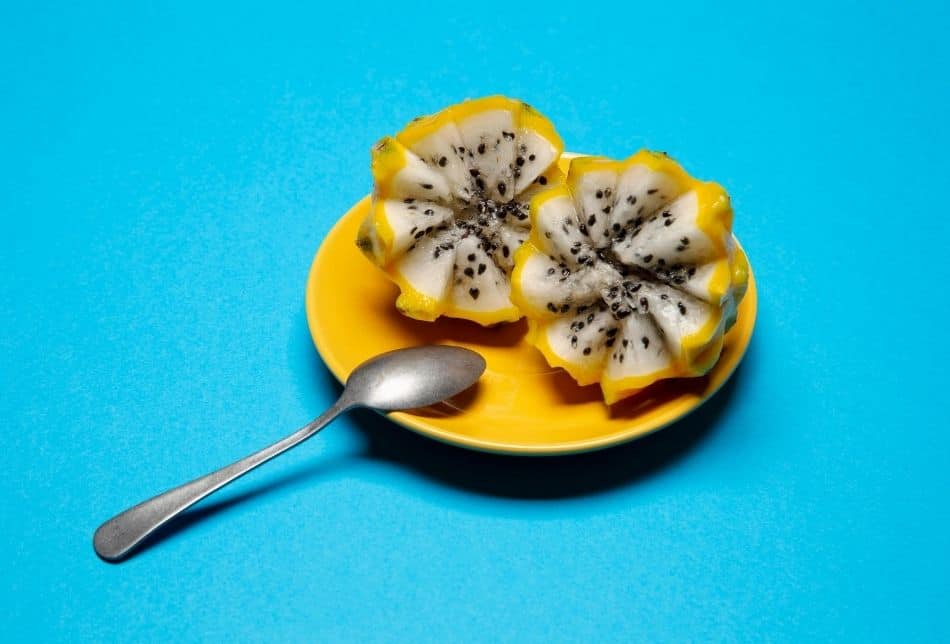
The yellow dragon fruit has a sweet and tangy taste, with a hint of citrus flavor.
It contains dietary fiber and more calcium than its red counterpart.
The yellow dragon fruit can be eaten fresh or used in juices, smoothies, and desserts.
They are heat-resistant and hardy in nature.
52. Yellow Figs
Native to Western Asia and the Mediterranean region, the yellow fig is a small fruit that’s often used in jams, jellies, and pies. It has a sweet flavor and a chewy texture.
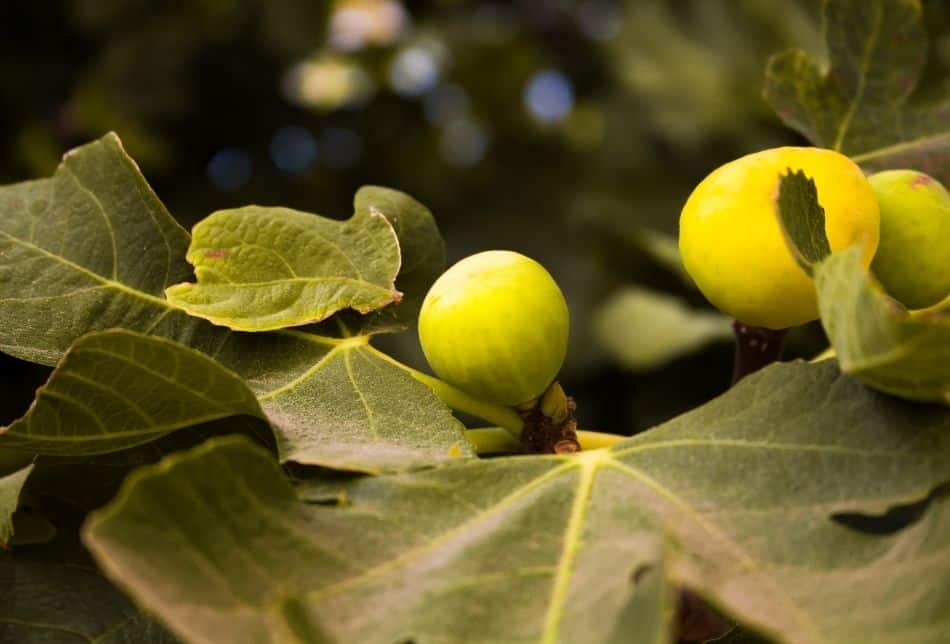
Figs are a healthy and delicious way to get your fiber, vitamins A & C needs.
They also contain phytochemicals with antioxidant properties.
If you’re looking for a delicious way to add more yellow figs to your diet, try roasted yellow figs with honey and balsamic vinegar.
It can be dried and preserved.
53. Yellow Lentils
Yellow lentils are a type of legume that’s closely related to green lentils. The tiny lentils are created by skinning and splitting green lentils.
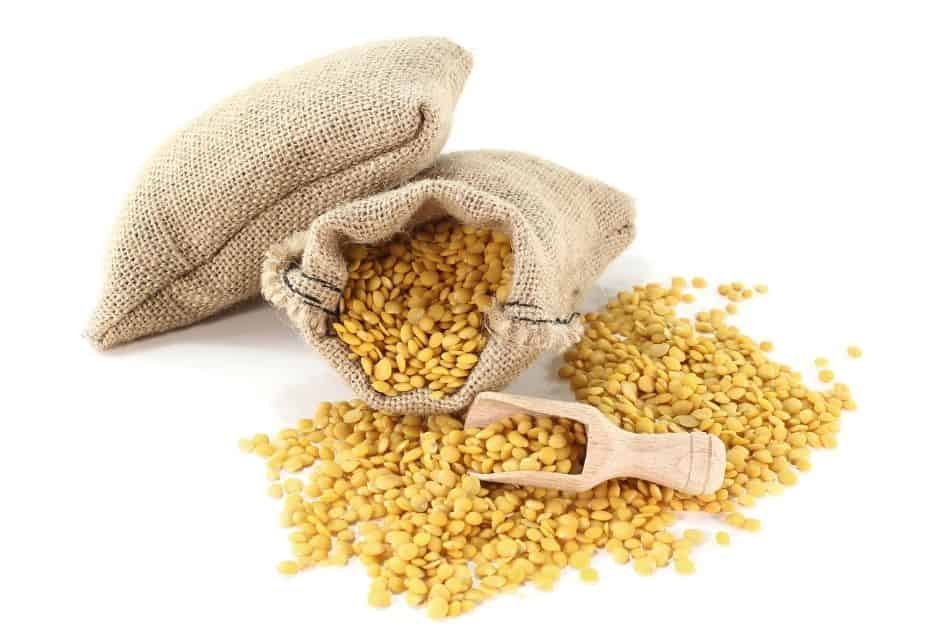
Yellow lentils become mushy upon cooking and, therefore, can be added to stews, soups, and purees for thickening purposes. Or it can be roasted for a snack.
Lentils are believed to have originated in the Middle East and were one of the first domesticated crops in the world.
Yellow lentils have zero cholesterol and are a good source of protein.
54. Yellow Nectarines
Nectarines are a type of stone fruit that’s related to the peach.
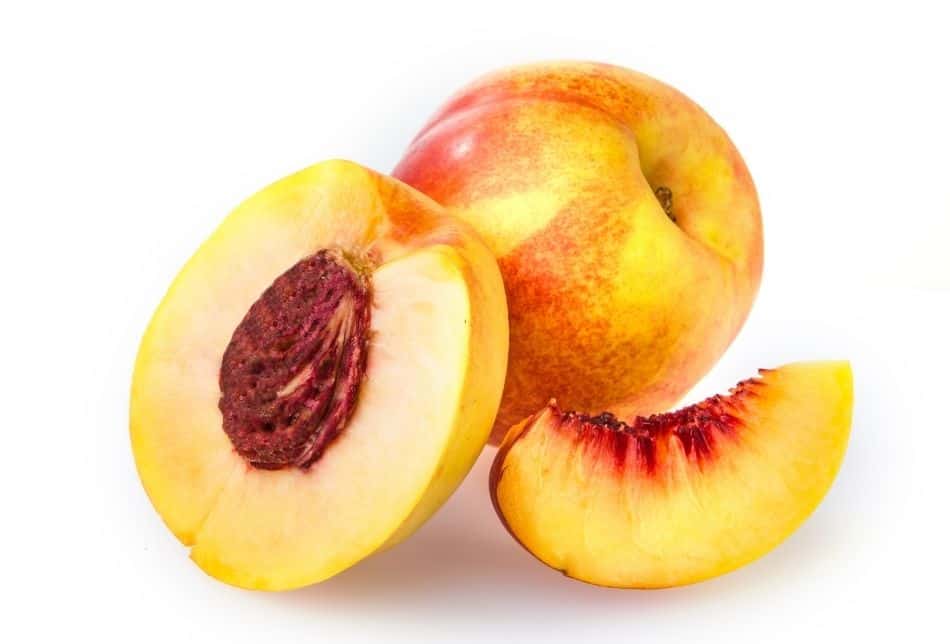
They have smooth, velvety skin and sweet, juicy flesh. Nectarines come in two varieties, including yellow.
Nectars from yellow nectarines have been shown to be an excellent source of fiber and vitamins A and C. They also contain phytochemicals that may help fight off illness or disease.
If you want to add more yellow nectarines to your diet, try using them in jams, jellies, or preserves.
You can also eat them as smoothies or yogurt for a sweet and nutritious treat.
55. Yellow Pepper
Next is the bright yellow pepper.
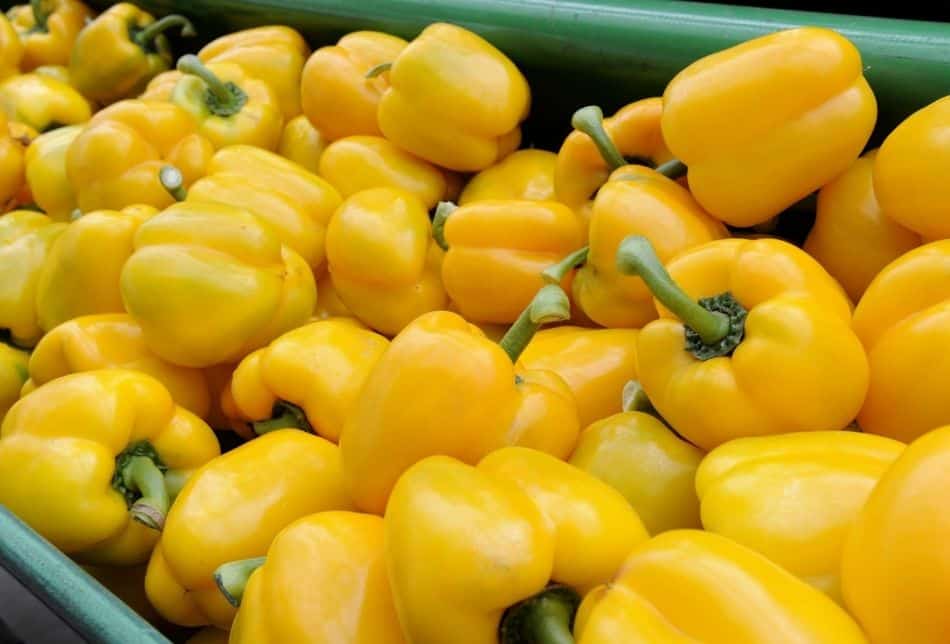
The name itself has yellow, but technically it is the green bell pepper allowed to ripen more before harvesting from the vine.
These peppers can be eaten raw, cooked, or roasted and can also be used in salads, soups, sauces, and stir-fries.
Peppers are from South America, Central America, and Mexico.
This yellow vegetable is a great source of vitamins C, A, magnesium, folate, and copper.
This yellow-colored food requires at least 30 days to ripen and turn yellow.
56. Yellow Rice
Yellow rice is a type of rice that’s been dyed with turmeric or saffron. It has a yellow color and a slightly nutty flavor.
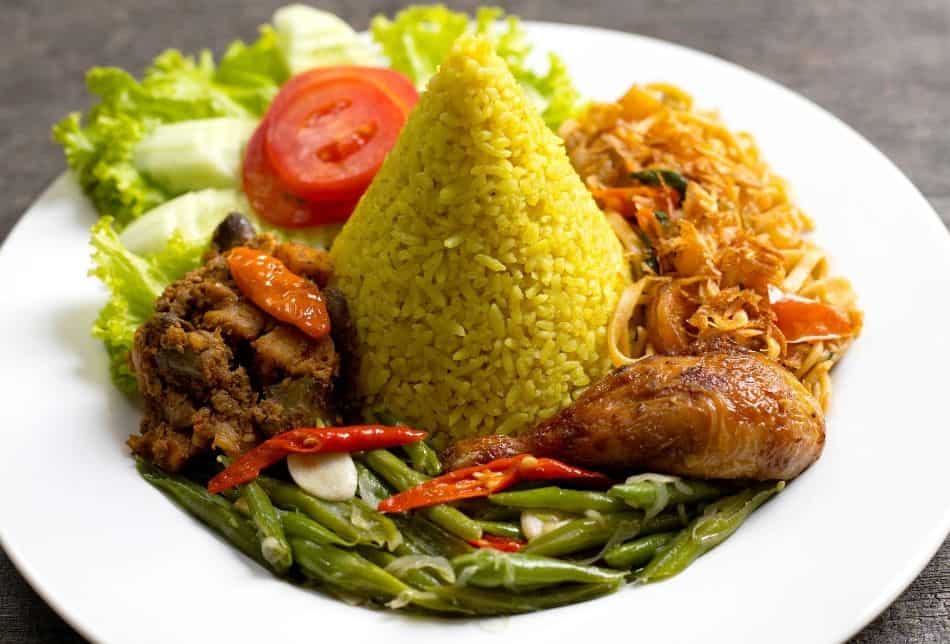
Yellow rice is found in Spanish, Indian, Iranian, West Asian, Caribbean, Moroccan, and Middle Eastern cuisines. It has vitamins B6 and C, as well as iron and magnesium.
It also contains plenty of mineral content, like calcium for strong bones or iron that will help keep your heart healthy.
Yellow rice is one iron, the most nutrient-dense grain you can find, with 8% protein and 2% fat.
57. Yellow Squash
Native to Central America and Mexico, yellow squash belongs to one of the most diverse fruits within the plant kingdom.
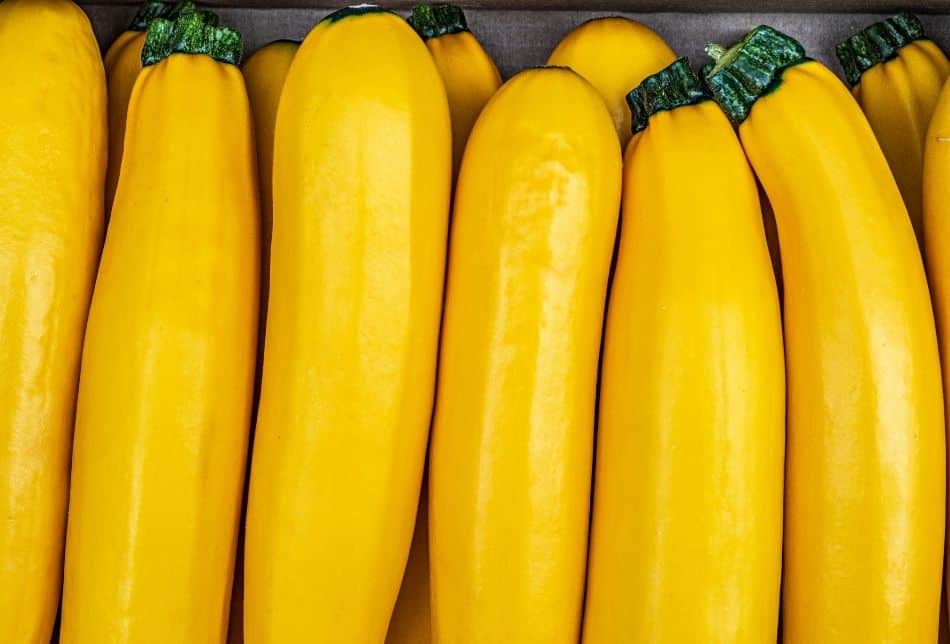
Yellow squash is like summer squash that has a yellow or golden-yellow color.
It’s slightly sweet and creamy in texture.
You can eat the yellow squash raw such as in salads, or even cook it in soups or stews.
Yellow squash is stacked with vitamins A, C, B6, potassium, manganese, and fiber.
58. Yellow Watermelon
The yellow watermelon is a unique and delicious alternative to traditional Watermelons.
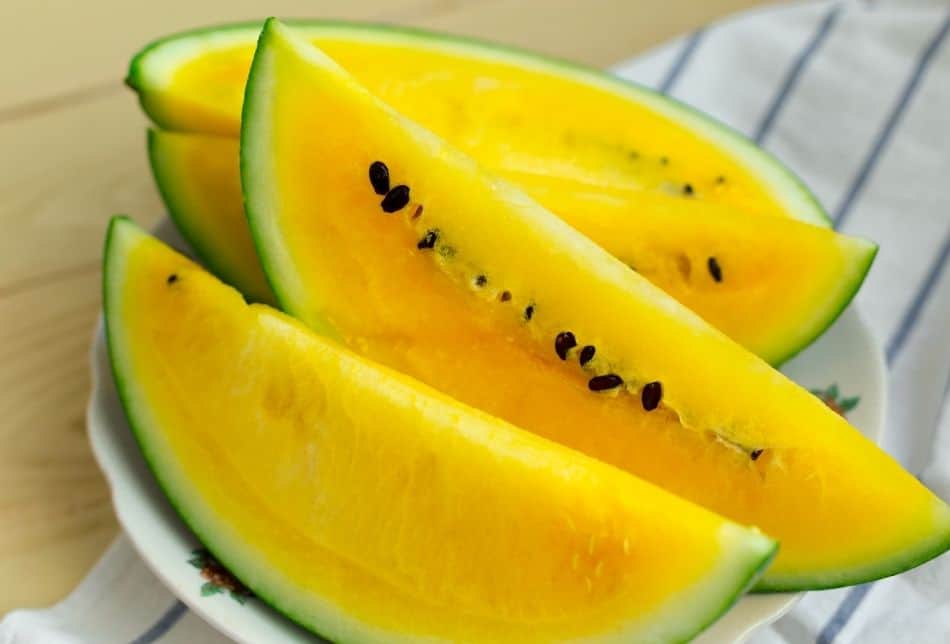
The honey-like flavor of this fruit makes it a great alternative to red-fleshed melons. It’s also good in vitamin C and minerals like potassium.
Yellow watermelons have been growing in Africa for 5000 years now and have the same nutritional advantages as red melons.
The yellow color of the flesh is all due to mutation.
59. Yellow Zucchini (Courgette or Baby Marrow)
Zucchini is from the warm region of Central America.
It looks like a cylindrical green zucchini and turns into deep golden color at maturity.
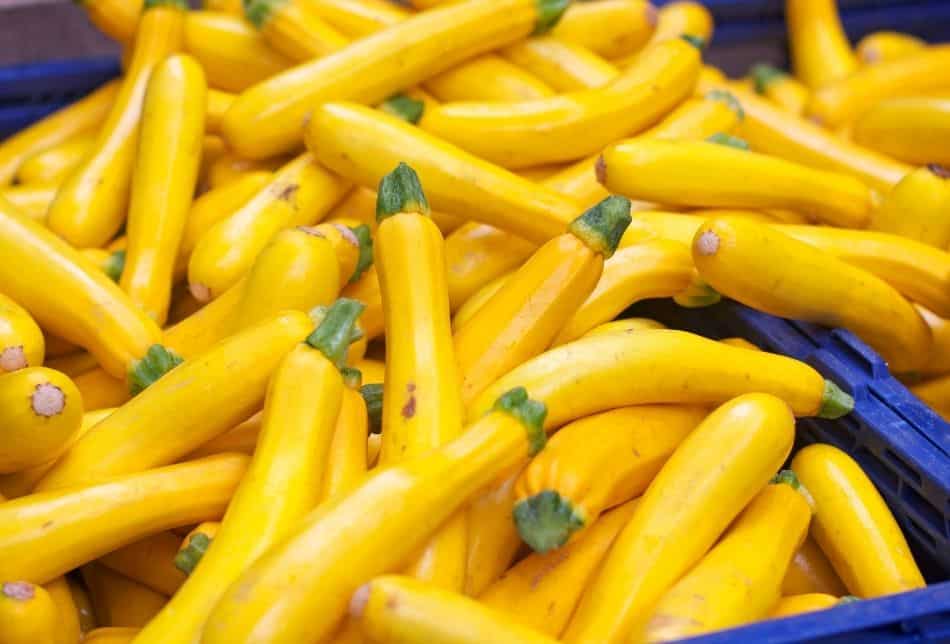
Yellow zucchini’s flavor is like the green counterpart but is a little sweeter.
The unique shape of this food makes it taste different from the traditional crook-neck and straight-neck varieties.
Its softer texture pairs well with mild flavors.
Yellow zucchini is a rich source of manganese.
60. Yukon Gold Potatoes
Yukon Gold potatoes are potatoes that have a yellow or golden-yellow color. The Yukon Gold was developed at the University of Guelph in Ontario, Canada, during the 1960s and 70s.
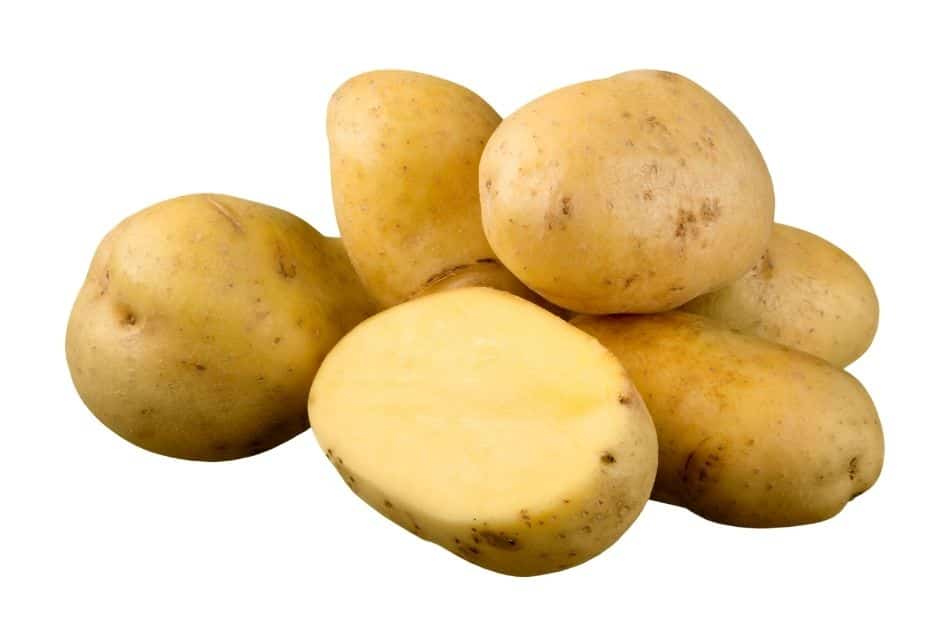
Yukon Gold potatoes have a slightly sweet and nutty flavor.
They can be boiled, baked, or mashed and will provide you with vitamins C and B6, as well as potassium and fiber.
When cooked, Yukon Gold potatoes tend to hold their shape better than other varieties of potatoes. This makes them ideal for dishes like gratins and pot pies.
They’re named after the Yukon River in Canada.
Final Thoughts
So there you have it, a list of yellow foods that are perfect for adding to your diet.
From bananas to mac and cheese, there are plenty of delicious and nutritious options.
So do not be scared of adding some color to your plate and enjoy all the benefits that these yellow foods offer.
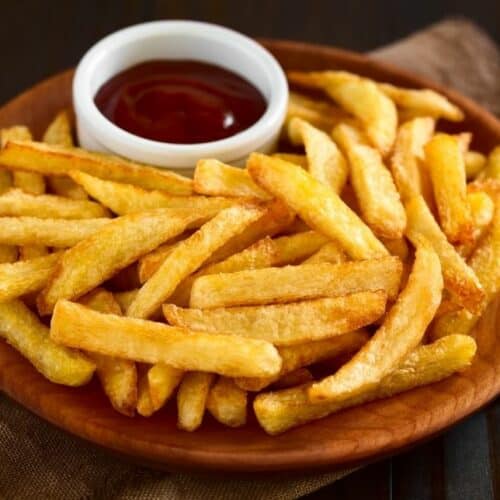
Foods That Are Yellow In Color
Ingredients
- Acorn Squash
- Asian Pears
- Banana
- Bartlett Pears
- Besan Chilla (Chickpea Pancake)
- Butter
- Butternut Squash
- Cantaloupe
- Cheese Puffs
- Chrysanthemum Flower Tea
- Corn
- Cornbread
- Cornflakes
- Cow's Milk Cheese
- Crookneck Pumpkin
- Durian
- Egg Yolk
- Eggfruit
- Field Pumpkin (Winter Squash)
- French Fries
- Gold Kiwi
- Golden Beets
- Golden Delicious
- Honey
- Jackfruit
- Lemon
- Lemon Boy
- Longan
- Loquats
- Mac and Cheese
- Mango
- Mirabelle Plum
- Mustard
- Olive Oil
- Papaya
- Passion Fruit
- Peach
- Persimmons
- Peter's Honey Fig
- Pineapple
- Rainier Cherries
- Rutabaga
- Saffron
- Semolina
- Starfruit
- Sweet Potatoes
- Turmeric
- Wax Beans
- Yellow Cauliflower
- Yellow Chili
- Yellow Dragon Fruit
- Yellow Figs
- Yellow Lentils
- Yellow Nectarines
- Yellow Pepper
- Yellow Rice
- Yellow Squash
- Yellow Watermelon
- Yellow Zucchini (Courgette or Baby Marrow)
- Yukon Gold Potatoes

